Over at The Trek.
Week 1 just went up here: Pennine Way week 1
While I am walking I do not want to manage cross copying content in two places.
Opinions, thoughts, ramblings
Over at The Trek.
Week 1 just went up here: Pennine Way week 1
While I am walking I do not want to manage cross copying content in two places.
Here we go, here we go again, yet another trip to the UK for some distance backpacking. To be honest I just really love the walking vibe in the UK. In the US taking your doggos on long trails adds some serious logistical nightmares, especially since most State and National Parks have a ban on dogs pretty much anywhere outside of “paved” areas. The UK however, there are dogs everywhere, and I just find the walking vibe pretty chill over all. I was already heading to Scotland for the TGO (The Great Outdoors) Challenge. and the wife gave me a pass for a second month so I decided to add the Pennine Way on the front end for the month of April. What is nice about the Pennine Way is there are quite a few Summits on the Air peaks, and I have also added a variation to include the Yorkshire Dales Three Peaks Challenge for an additional two SOTA peaks.

What drew me to the PW first was I wanted to make sure I was in walking shape for the TGO, and I am essentially walking to Scotland along “the spine of England”. During our Coast to Coast last year we crossed paths with the PW near Keld. Since I missed out on some travel last year for some personal things and after my success of doing SOTA + Thru-hiking on the WHW, I wanted to step it up one more level with a trip that was >200 miles. The PW offers that, and M1EYP did a similar style trip back in 2013, plus my 3 peaks challenge variation gives me plenty of distance to get strong. I am allowing 20 days total on the PW and looking to mostly wild camp it, however I do have a couple of nicer stays which will also be resupplies. Also when in a town named “Once Brewed” and a pub named “Twice Brewed” you have to pay the extra just to check it out. Of course I will be finishing with the Border Hotel before moving on.
After the Pennine Way, I have about 15 days before I need to be in Glen Shiel for the start of my TGO Crossing. I’ll probably get up there a little early as the 5 sisters of Kintail looks pretty enticing from a hiking (and Summits on the Air) perspective. The Lakes are calling my name as usual so I may roll that way some too! Kendal here I come for some Mint Cake!!
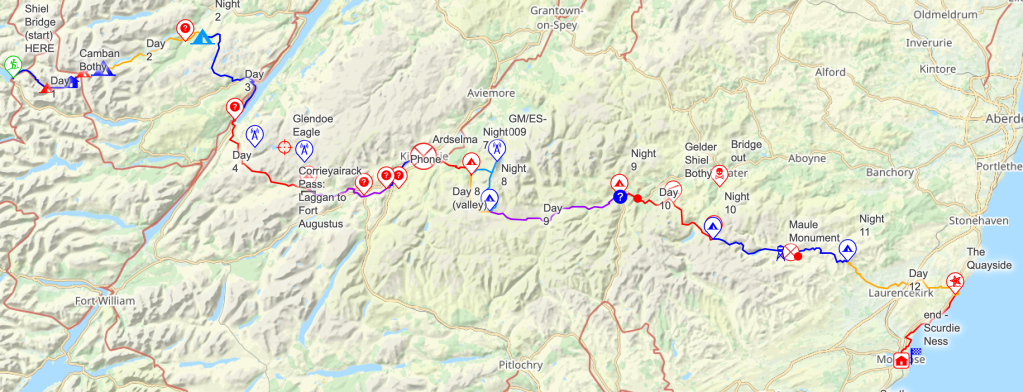
The TGO Crossing starts somewhere in the second week of May and finishes two weeks later. I only have 3 days to get from WAY up North back to London. Lets go, fingers crossed for no train strikes!!
So now for the nitty gritty, this whole trip like is one big backpacking trip (albeit a posh one), and I will do everything with a single backpack. Note: Trekking Poles, tent stakes and a few other things will have to go under the plane, and I’ve got a few ideas for that.
So what does the gear load out look like for this trip (and keep in mind I am not a weight nerd. Plus I am comfortable with 20 mile days at 40lbs, so I am shooting for 35lbs just to be safe. Although keep in mind, food tends to be what pushes most pack weights into the ‘uuugggghhh’ realm, and with this being the UK there are chippies, kebab shops and cafes everywhere so I’ll probably only ever have 2-3 days of food on me at any given time. I will have to up that to 4 days though once I start the TGO.
So what gear am I taking for 2 months on the road/trail/travel? (note other than the Drink LMNT link, all other links are not affiliates and go direct to the manufacturer were possible. I am not getting paid/sponsored/asked just including the links because it is gear I believe in). The list is kind of long, and I will skip the little odds and ends and stick the macro items. AS of the time of this writing and for the things going with me, the pack weight is at 24 lbs. Once I add in food (mostly breakfast since I am wild camping most of the walk) I’ll be closer to 30lbs
I’ve embedded my walk through video at the bottom if you do not want to read it all, it’s about eight minutes long.
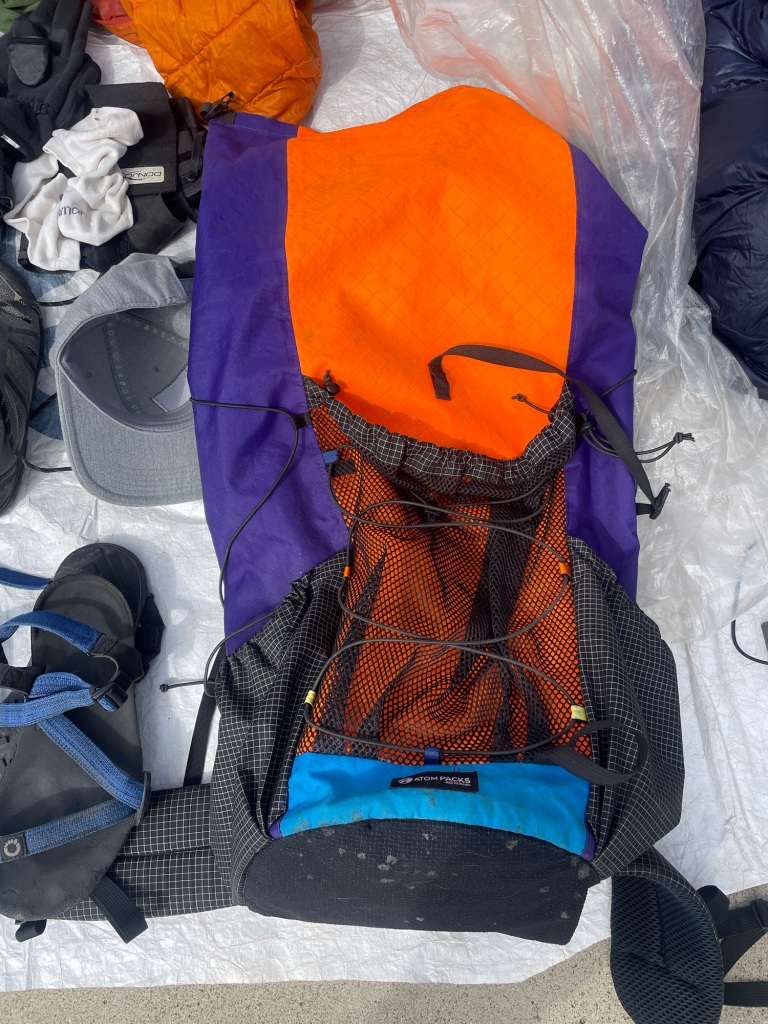
Clothing:
Other Odds and Ends:
Two days in Guadalupe Mountains National Park for a day of hiking the Texas State High Point
In the quest for state high points and available time for getting up to the PNW we spent two nights at Guadalupe National Park. The Guadalupe Mountains are a North/South running chain in the West of Texas and South East of New Mexico. This area is also close to Carlsbad Caverns which if you have the time is worth a stop over as well. This mountain range at one point was a reef bed and many of the fossils date back to some 40M years ago during the Permian Age1.
There are two main campgrounds, plus a horse corral. The Pine Springs Campground is at the base of the hike for Guadalupe peak which was my goal on this outing. The Pine Springs CG uses part of the parking lot for 13 “RV” sites, and there is a separate loop in the same area for tent campers to make for an easy leisurely start to get up Texas’ state high point. This area is really close to the Central/Mountain Time Zone line, so at times your phone will present with one or the other. Hopefully while you are there time is not that important because it’s hard to know what time it really is :D. My Garmin once I started my GPS track was using MST even though my phone was still showing CST.
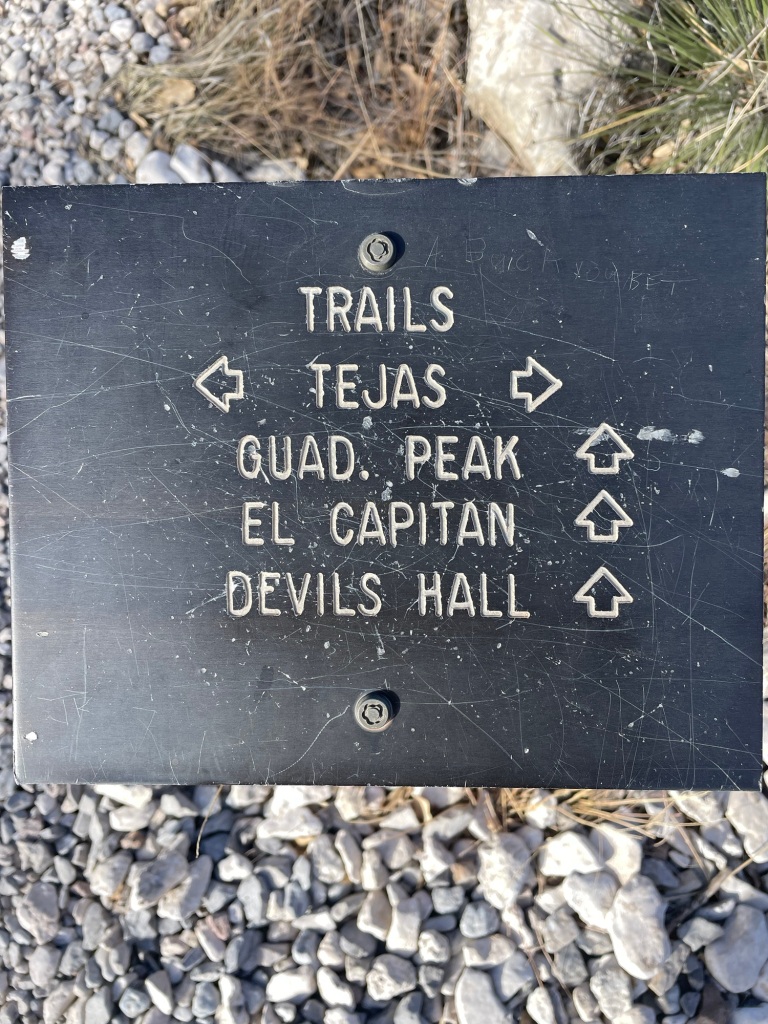
The steepest part of this trail, and the part that is going to make or break you is the first two miles. Lots of steps made by people with long legs and a short torso, so for those of us who are say…average height (or shorter) and are a 50/50 torso/leg split do have a bit of extra work. The other option is follow the others up the side of the rock steps creating new erosion channels (see principle 2 of LNT for why you should not do this). I wanted an early start because as usual the goal was Summits on the Air, and hopefully some EU/UK DX. I was moving pretty early on and greeted by the park volunteers at the bottom of the trail with the usual questions of “enough snacks, enough water, layers?” etc. Today’s weather was calling for high winds and temps in the 40-50s, towards the top there was also some snow, ice and mud on the trail. Also this is a pretty arid area so a good amount of water even on a day like today is necessary. An interesting combination of conditions to really have to prepare for.
Up I went making a good pace ahead of my hiking partner as I knew I would be hanging out on top, and wanted some time to setup. Normally I would not say separate from your group, but this was a pretty straight forward trail with out any real turn offs to end up in the wrong area. I made pretty good time overall for maintaining a consistent pace; the ascent is a tad more than four miles with an elevation gain of about 2900 feet. The Munter method would put this at a 3:45 minute hike, I knocked it out in 2:16. All that walking (and swings and squats) pay off :D. As far as the ascent went and I had an idea that because the trail is on the canyon side of the hills that we were getting a funnel effect. At about 1.5 miles the trail hooks hard left at a rock out cropping and this was the worst bit of the winds this day, but after about 200 yards you end up in a tunnel of Pine trees that cut the wind down for the next bit. I will note that this trail has a bunch fo exposure, which made for a fun descent (more on that later). The last mile was where the snow, mud and some ice was. I was quite surprised to see ice given the semi arid location, but some winter/wet weather had ripped through a few days before. So, be aware that winter weather is a possibility.
Setup the radio gear in a way to not be too wind effected and the wife was not far behind. She too beat the Munter Method timing by a good hour! For the SOTA stuff, I spent 2 hours activating across 5 bands all cw and managed 58 contacts. Most of the DX came on 21mhz and 28mhz was great for the whole US. DX included France, England, Spain and Switzerland.



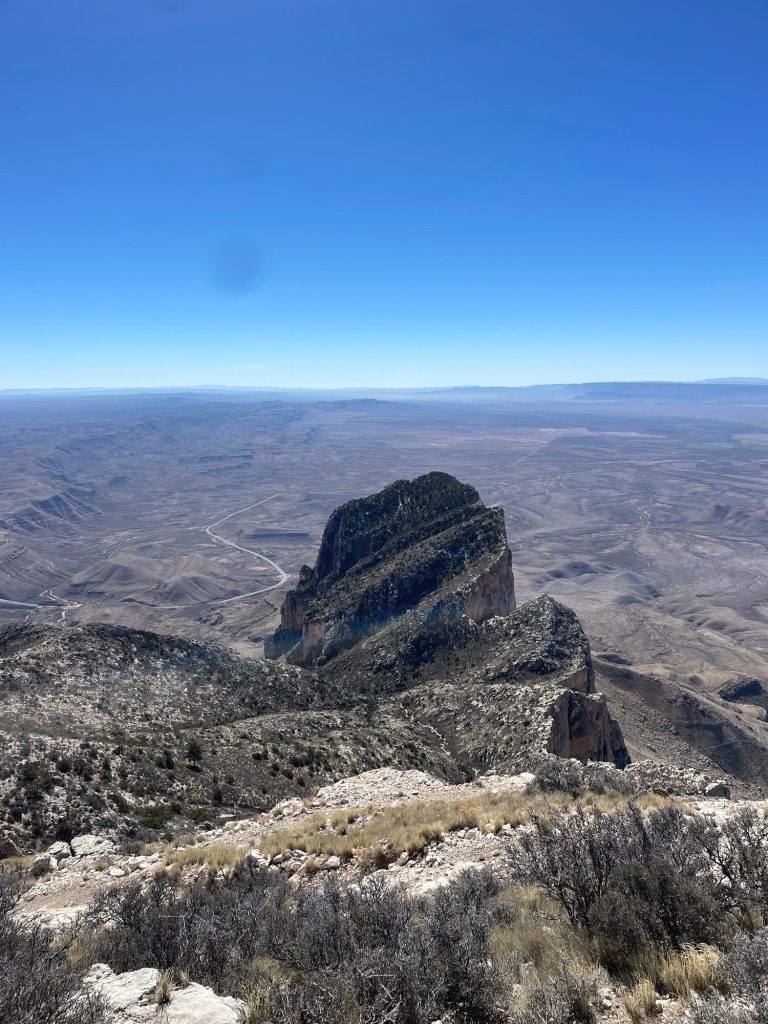


One of the rules I hike/peak bag by is “anything you go up you have to come down” and that has served me well, as noted in the Big Bend post I almost broke that rule but today is not about me and my descent. I’d been aware of this one particular group on my ascent and while I was hanging out. As I was about 200 yards down I found a party who had one individual near tears and almost frozen in their tracks. This group had left about 30 minutes before me from the summit and this was as far as they got. I called out a bit ago that there was a fair bit of exposure to this walk, you are above treeline, while the summit area is pretty big the trail is exposed with long steep drop offs on the sides and this individual had reached their breaking point. They were not having it. I decided it was time to engage and pull out all those skills I’ve picked up over the years to walk the group down and overall it was a great experience. The single most important thing you can do if you do engage to help someone is listen to what they are saying.. Not just hear, but LISTEN. I had noticed that this person kept asking us to walk down in front on the harder step down. Basically they were learning what we were doing with our feet, so I made sure to wait every time we came to one of those dicey sections. Now keep in mind, I love it when a hike takes me into evening and I can catch a sunset, and I had an idea that this would happen. At one point because the cellular service is pretty dodgy I ended up having the wife monitor Simplex on the radio just in case we needed other assistance up there. Note yes there is some cellular service but it is dodgy at best, and there are parts of the trail where you go 30 minutes with no service (including no SOS), so plan accordingly. It took us about 4 hours to get down, but we all managed to get down safely. Hopefully this individual was not too turned off by the experience and their group of four does continue venturing out into the hills. I really had an enjoyable time talking and walking with the three who remained with me on the descent.
This was a great area to stop and play, and I recommend it if you are in this area, that said book early. We did end up having to move from one campsite to another in order to stay for two days. From a hiking preparedness perspective, this is a reminder too/from me to always turn around on your way up to make sure that when you look down you do not freak out. Of the people I have helped over the years both in the name of SAR and as a good samaritan, the mental hurdle is one of the hardest things to overcome when you are in that exposed out situation. We can always warm up, consume calories etc, but when we are freaking out/disregulated getting re-regulated can be the biggest hurdle to getting back on the move. Not a lot planned for March other then work our way up to the PNW and then back down to SoCal , but that said April and May will be another springtime adventure off in the UK.
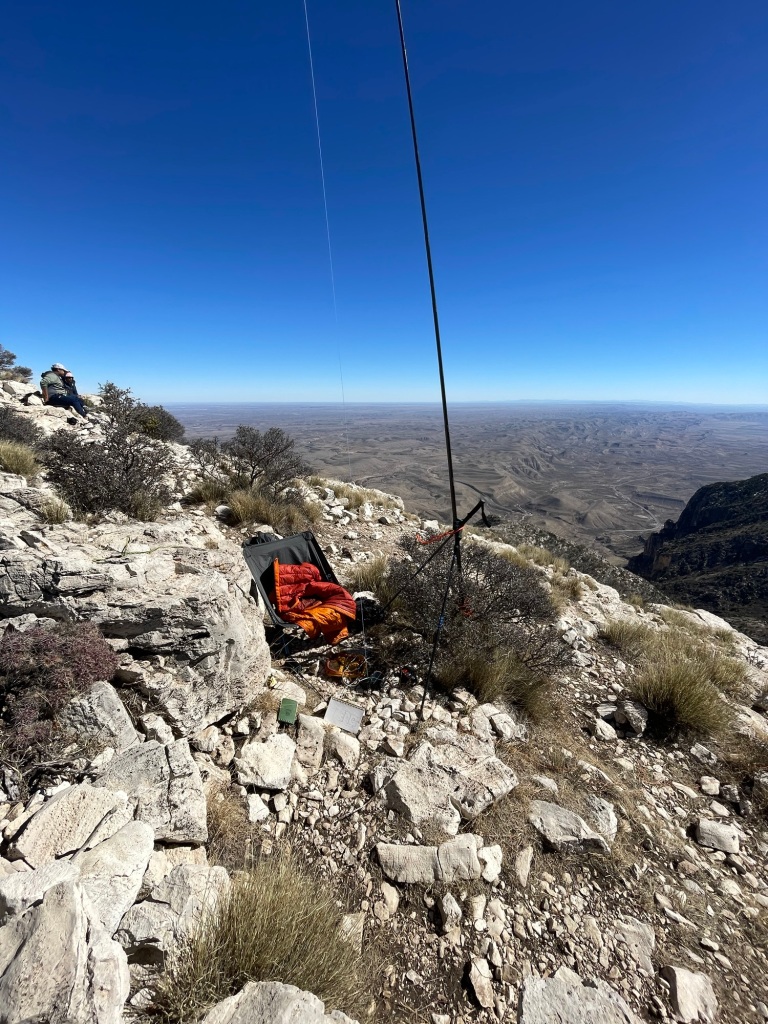
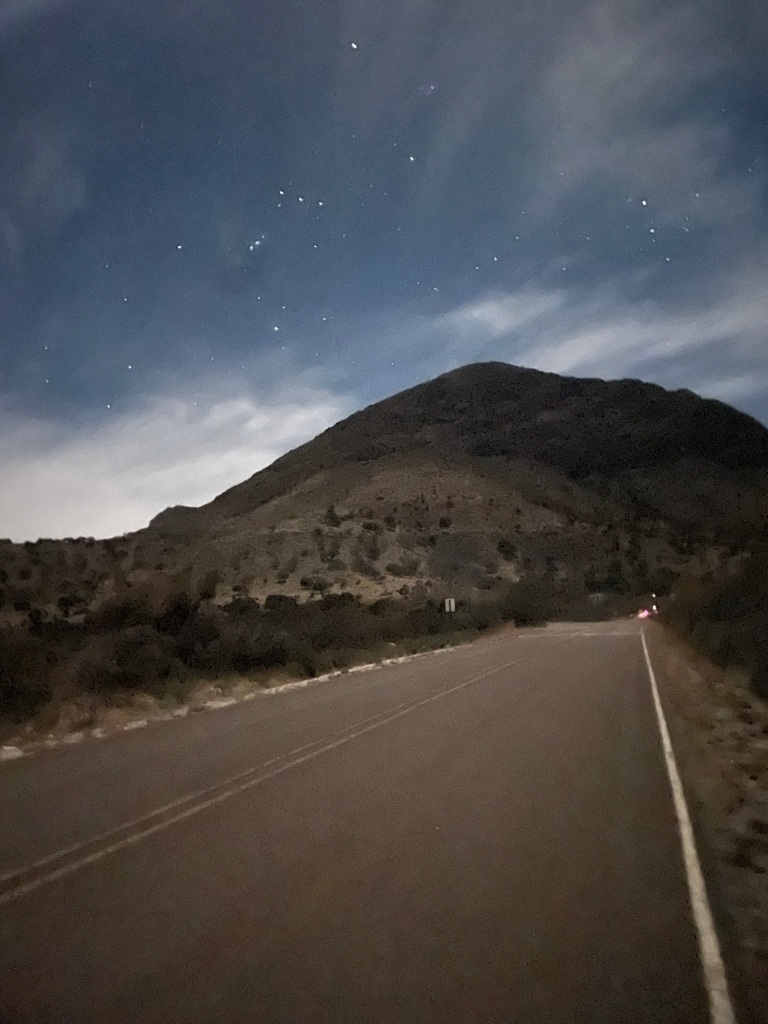
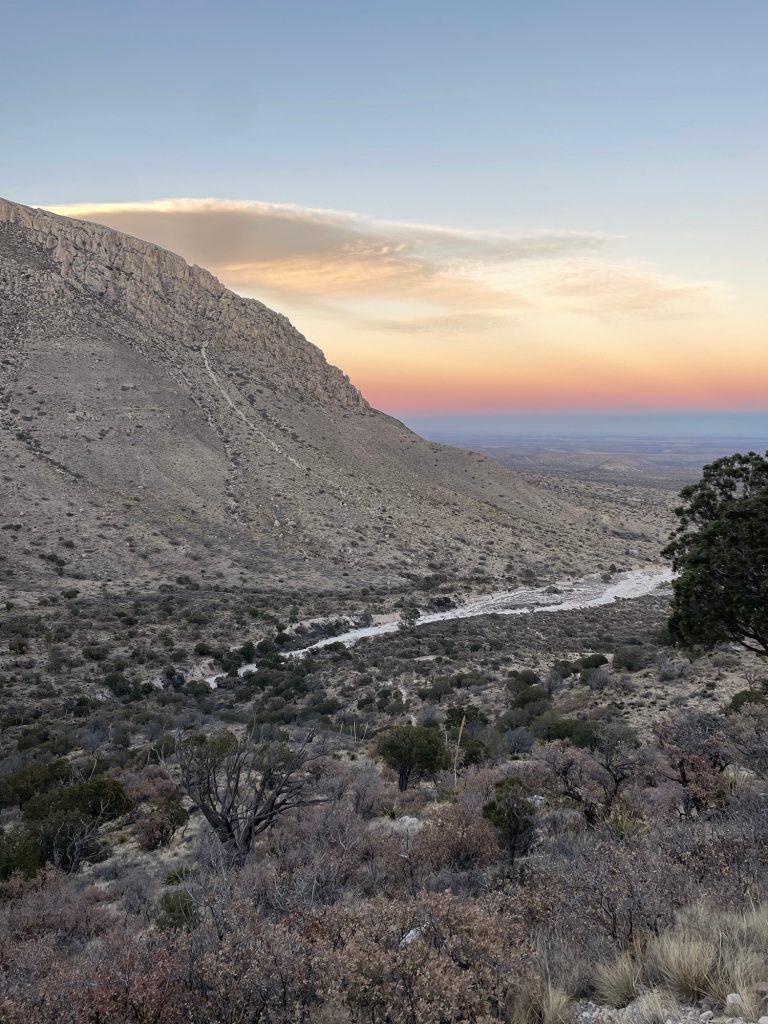

After a month in Florida it was time to start westward. Big Bend seemed like a great next place to hole up for a little bit given its proximity to nothing. I was hoping to score a week in the Chisos Basin CG, but that was not happening. We ended up with M-F in Rio Grande Village, and somehow scored the weekend in Chisos. I knew I wanted to do at least one peak (Emory) since it was the park’s high point, and there is enough other stuff to do as well to fill the 8 days we were going to be here.
At the Rio Grande Village CG there is a “nature walk” that goes down to the river, but also a little hill to go up and watch the sunset. We got there with plenty of time to enjoy both. If you have good photography equipment take it with you. The Sierra del Carmen range light up with some amazing hues of reds and pinks thanks to the color of the rocks. I came back for my night wander to do some stargazing. It had been way to long since I have had a good dark sky.. While the night sky here is good its not middle of Nevada dark, but it is still pretty good none-the-less. I was just stoked to have a great night sky.
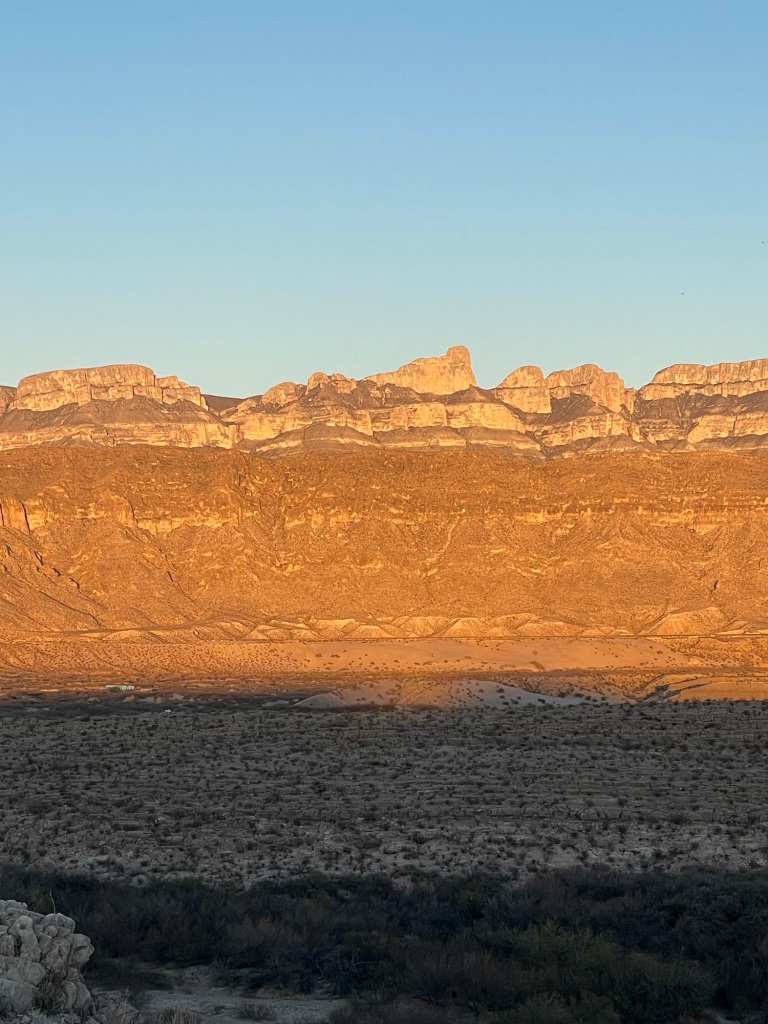
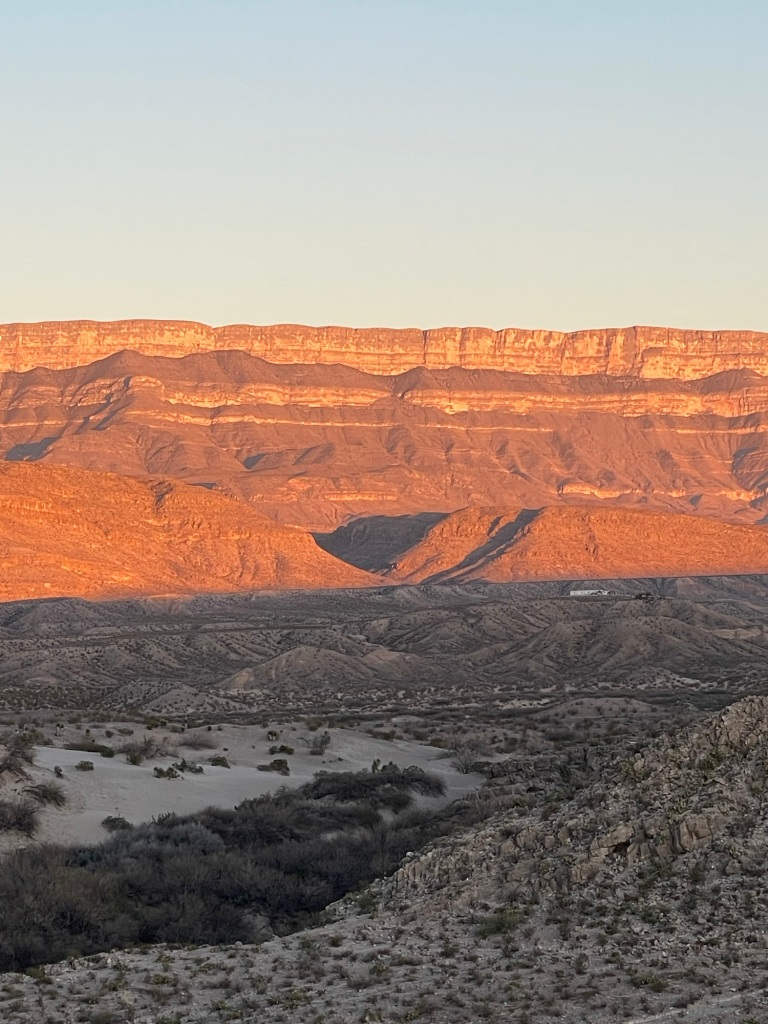
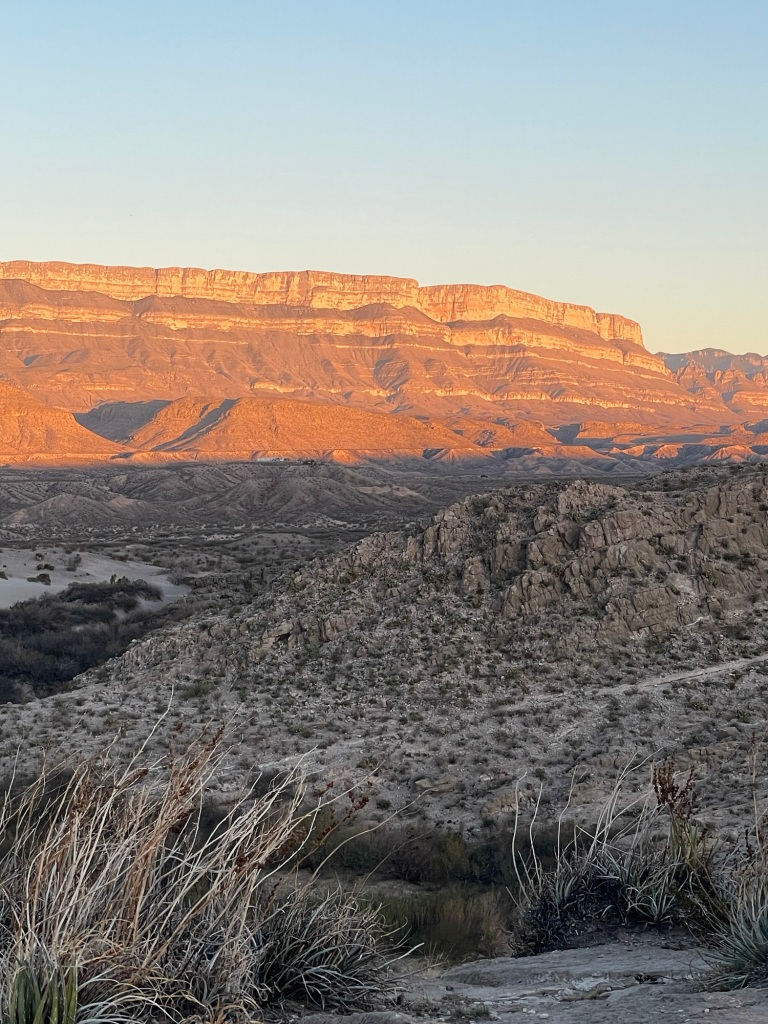
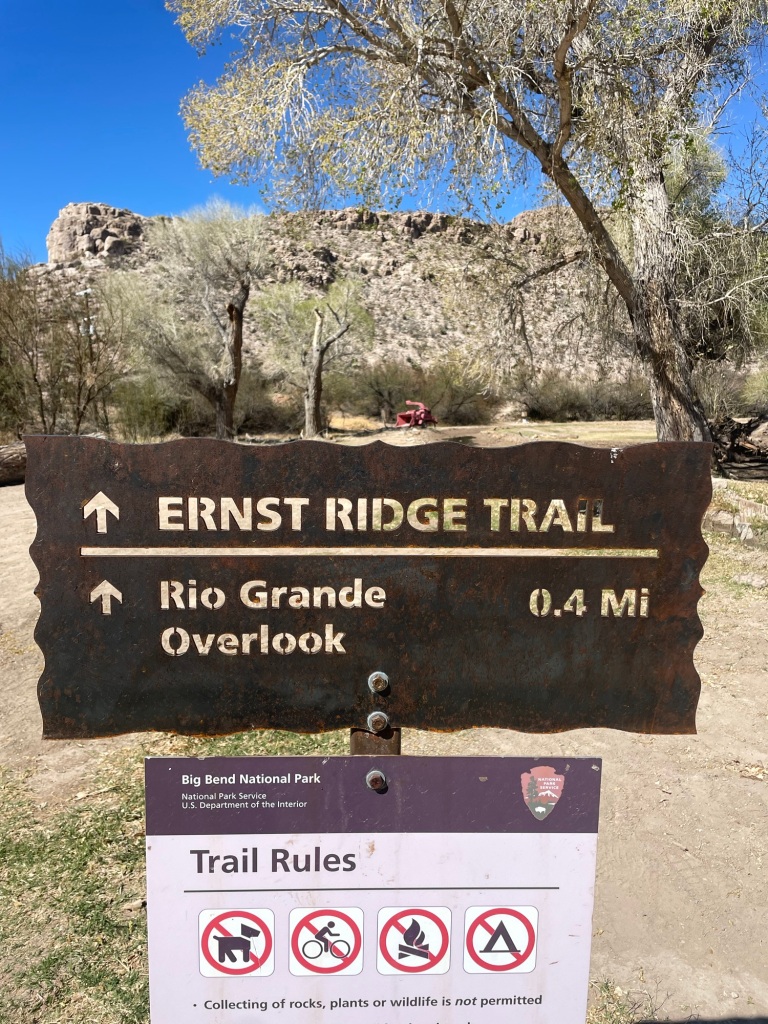
Today was a fun little jaunt along the Rio Grande to the Hot Springs at the end of the trail. It was supposed to be a 6-ish mile out amd back, but we started from the CG so that pushed us closer to 9 miles. This walk offers a lot of interesting site seeing that covers geology as well as natural amd human history. The walk offers great views of the Rio Grande, the Sierra de (mountains), fossils and petroglyphs on the walls around the Hot Springs. Oh yah and hot springs too, which (so and so ) Langford back in the early 1900s created a resort nearby. After lunch amd some time checking out the area history we headed back.
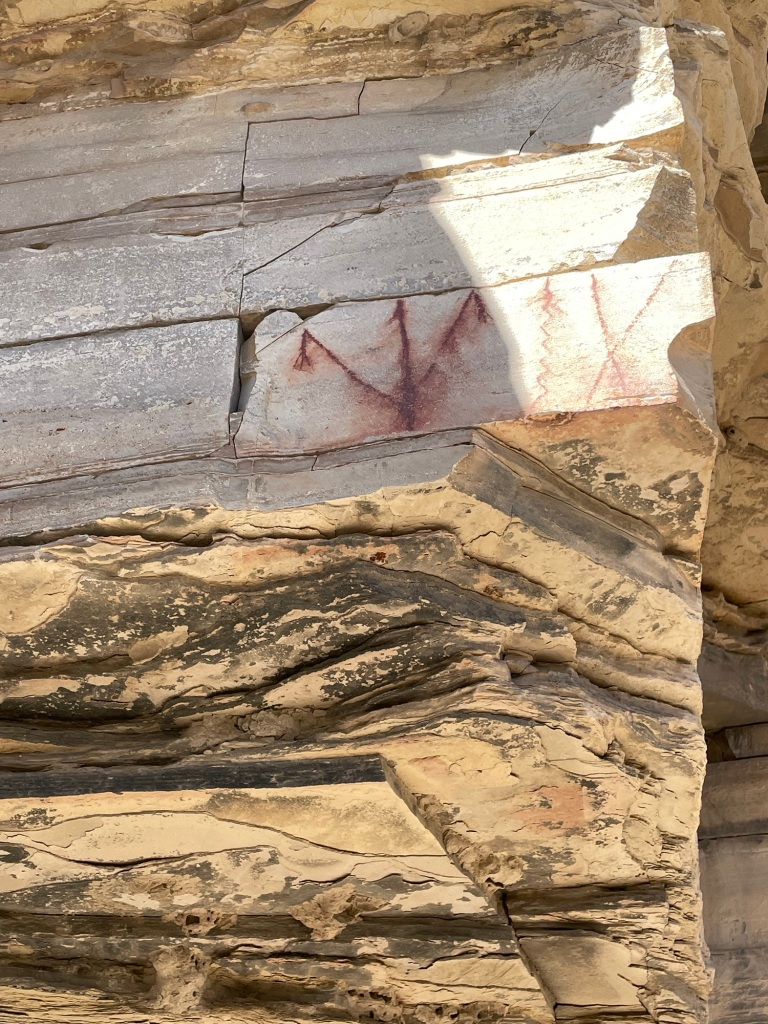
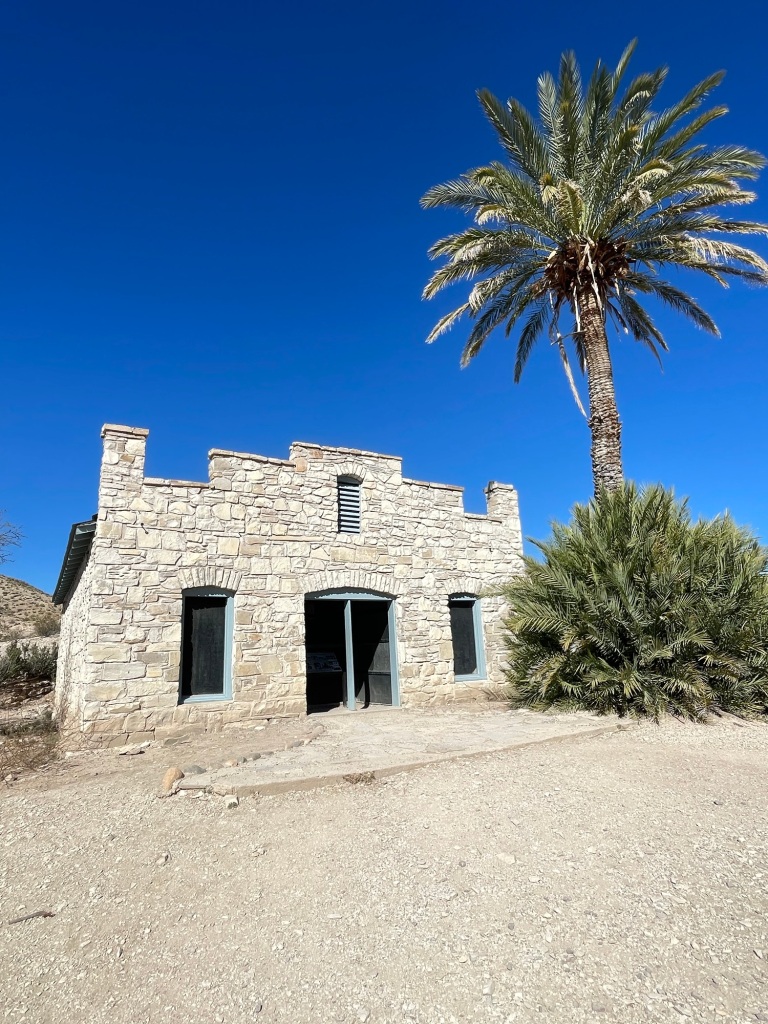
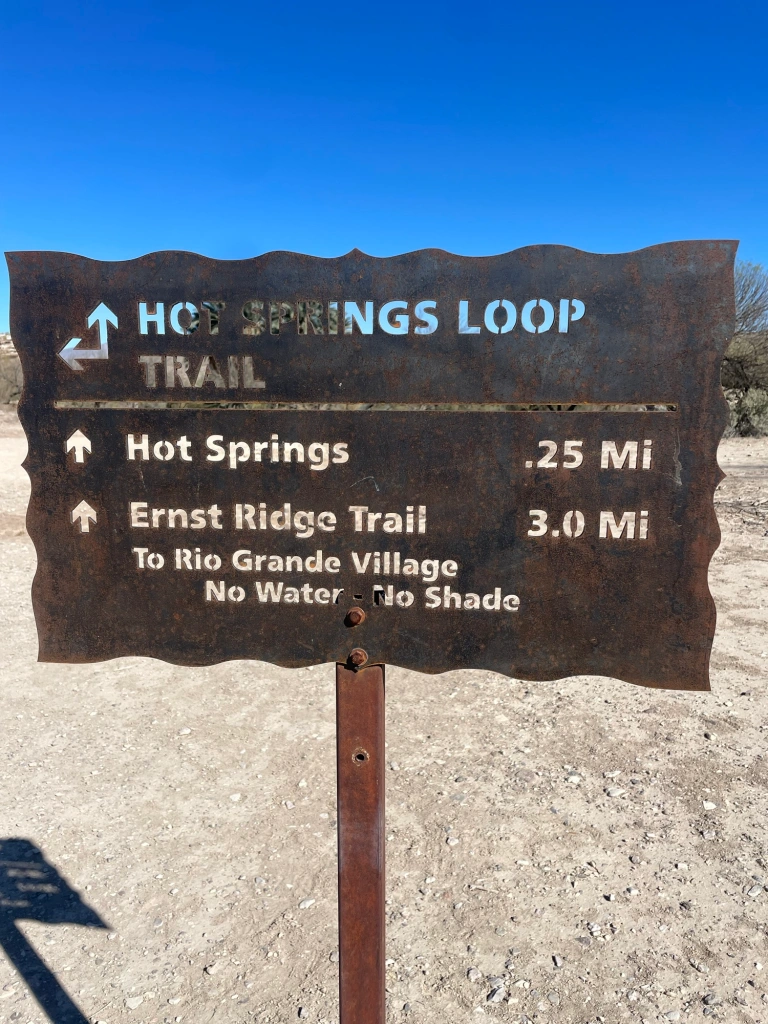
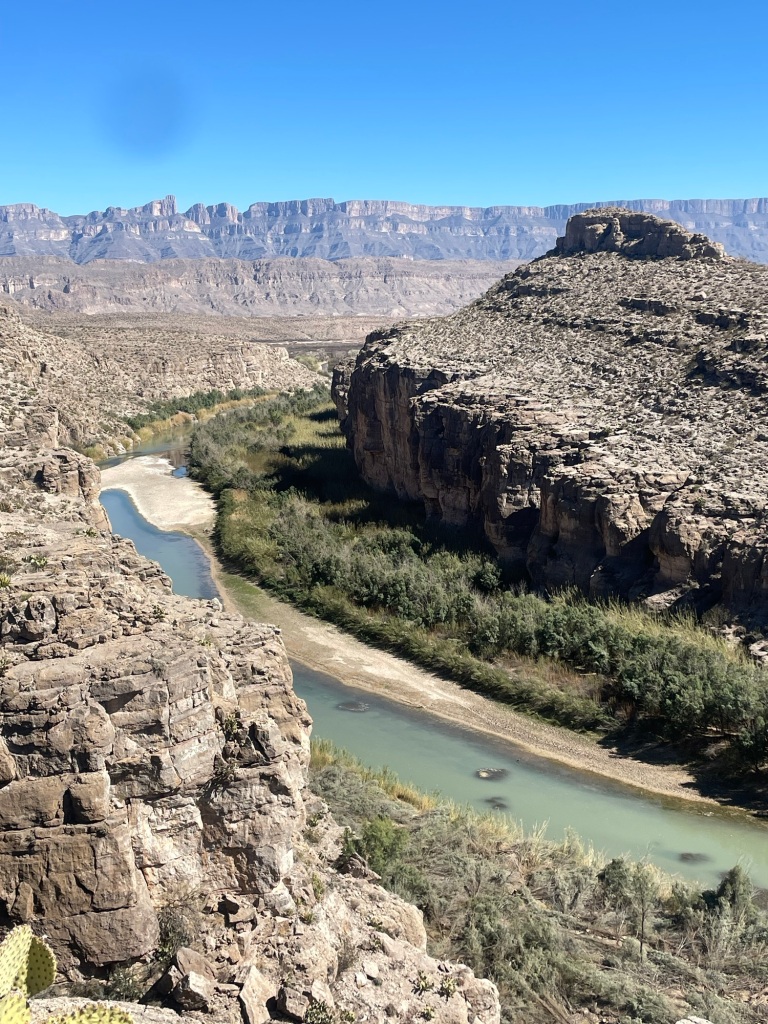
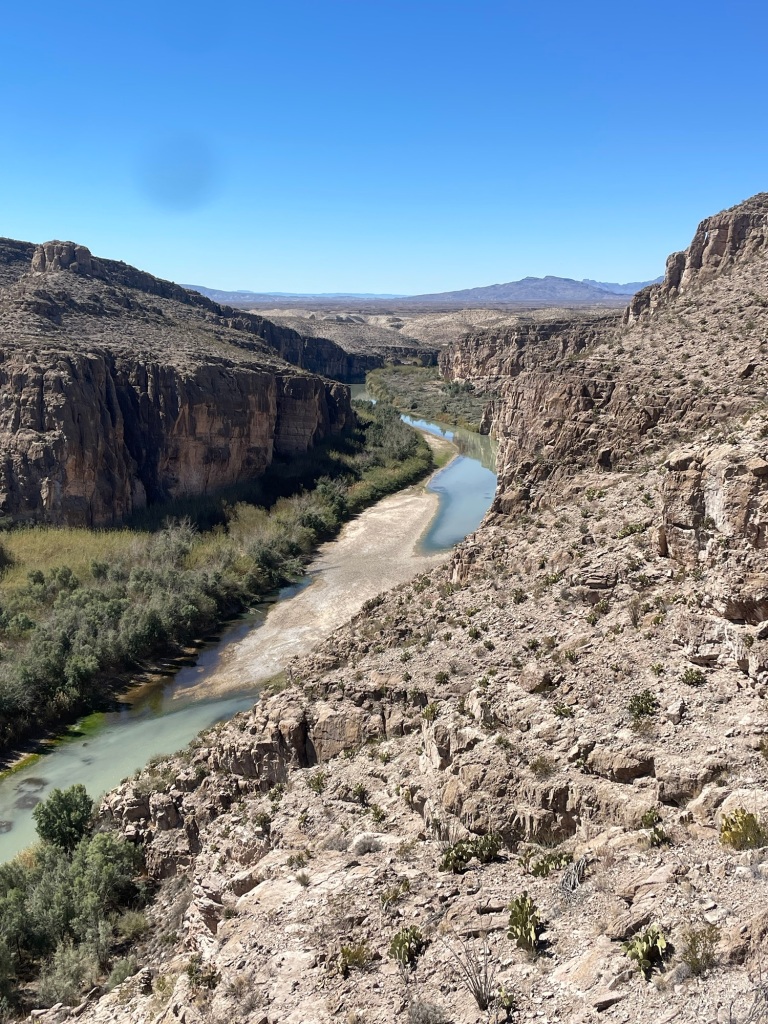
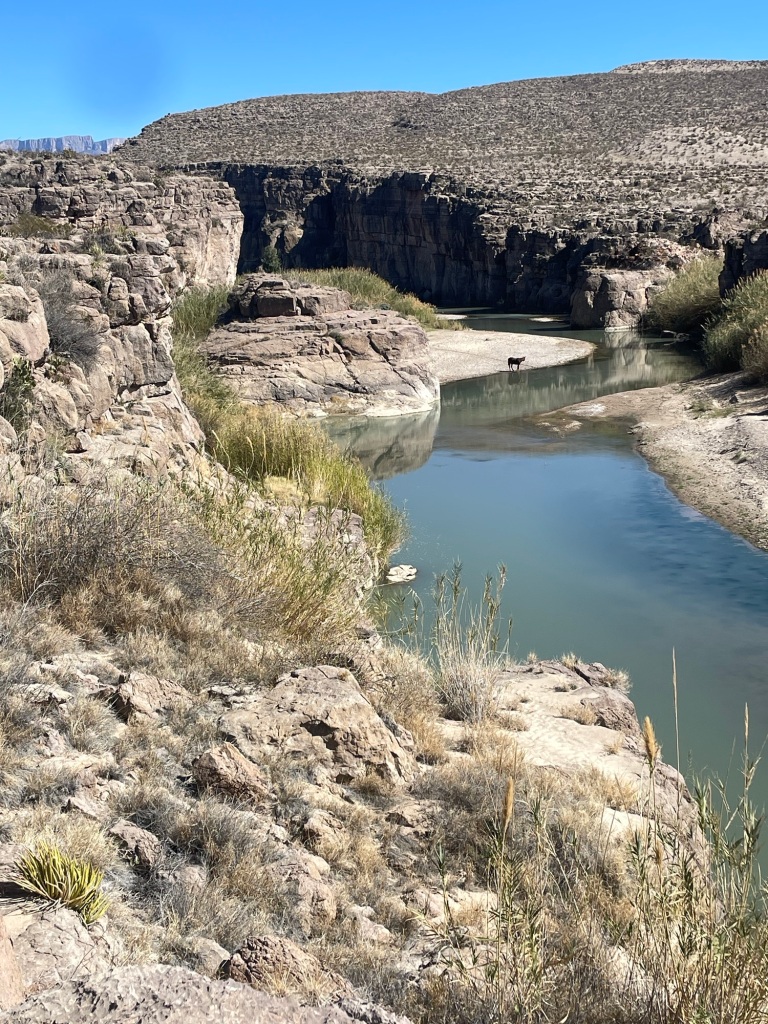
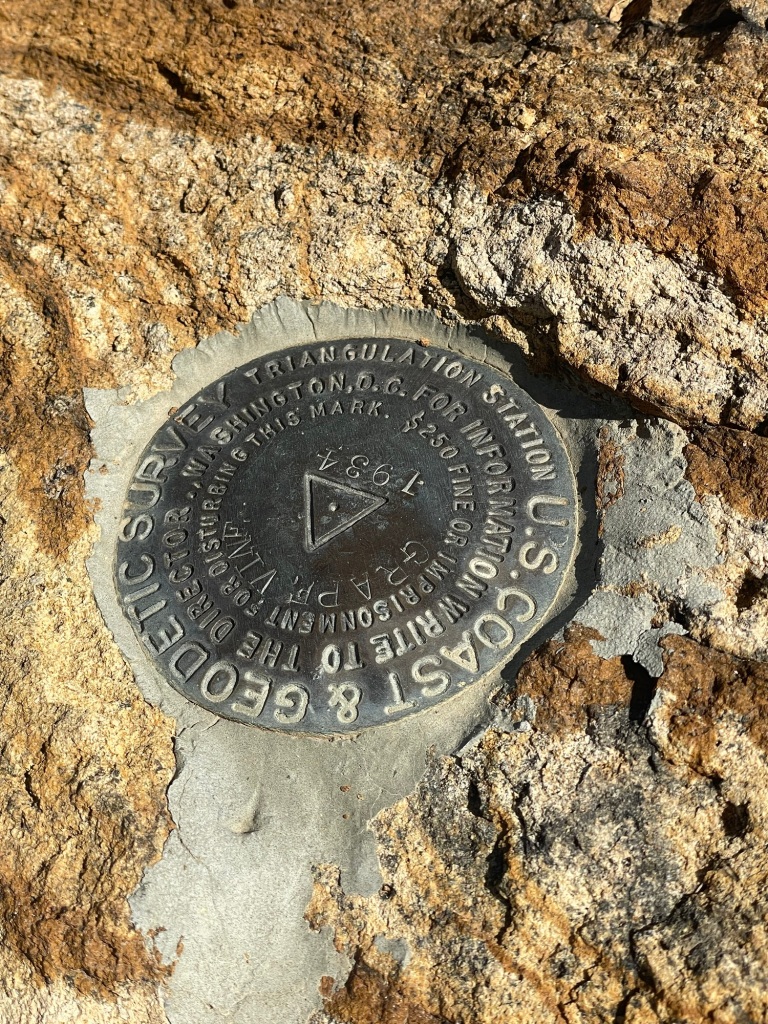
The plan today was to head over towards Grapevine Hills and walk out to a balanced rock, however i checked SOTAmaps and realized I was looking right at a peak. It had been six weeks so the urge overtook me to send Meesh on her way and I opted to run up the hill. One thing i will note is that every kind of plant here wants to stick and prick you whether its a cactus or not. This is not the same as say the whitethorn or manzanita i encounter regularly in Nevada. It was the first peak that I was trying out a new EFRW built with K6ARK’s balun kit. I had been using a linked EFHW for the past couple of years and the polystealth wire was starting to get worse for wear. At the end of the day I wound up with about 30 qsos on 28mhz and 21mhz including on contact with Northern Ireland. Most of the contacts were North American based, so not too bad given the last minute decision and no real alert, or other activators in the hills today. Tomorrow we are headed to the Lost Mine trail and I will snag Casa Grande Peak.

I wanted to do some Summits on the Air after my day on Grapevine Hills, and I had been eyeing Casa Grande or it’s neighbor Lost Mine Peak located in the Chisos Mountains sky island. . After pouring over maps, and data I chose Casa Grande, and to be fair it was the more impressive looking peak overall. I took off ahead of Michele from the parking area as she was not following me up this peak (and for good reason). The first mile you follow the Lost Mine trail, and then turn off onto a no longer maintained almost goat trail to the summit. A goat trail it was, it looks like quite a few people head up this peak such that there are multiple goat trails in the absence of a well flagged/cairn’d route to a peak that has a steep approach. Some of the terrain encountered did include a little bit of class 3/4 scrambling (because I like scrambling solid rock instead of fighting with Talus and Scree), and some talus/scree runs that at least have some trees that can be used for hand holds. Once you get up the last gully the trail levels out pretty good and the last 50 or so feet of elevation is a gradual trail. At one point you cover 500 feet of vertical gain over 700-800 feet of horizontal distance. The summit offers a 360 degree viewpoint as far as the eyes can see. Look South towards the Rio Grande, the Sierra del Carmen range and Mexico, glance across the way at Emory Peak which stands close by (and was done later in the week), so plenty of views to be had. Another successful SOTA activation, so we wont go into that, but lets shift into the down route. Looking downhill you can see quite a few options including where some individuals have just bombed straight down the talus fields, which on the map does cut off a LOT of distance back to the parking lot/trail head. I’m not down with that though as rocks hurt and the angle was steep enough that a controlled descent was just not possible. If you can handle that, more power to you. That said as I was trying to contour around, I did wind up on yet another rock band where I was doing a bit of low grade class V climbing but also having to contort and bend to not end up wearing the prickly pear cacti. I almost managed to get cliffed out at one point too, but found a good animal use trail to finally rejoin the “correct” (old/original) trail back to the Lost Mine trail. All in all it took me longer to get down than get up since I had to do a lot of route finding/navigating off the summit. So be warned if you decide to go after this peak.
Not a lot to really report here, we slow rolled out of Rio Grande Village to Chisos Basin. This is considered “an island in the sky” which I called out above. It was much cooler, but also much more crowded as most people are here to hike some of the trails in the area as well as bag the higher, but easier to reach Emory Peak. There are a plenty of trails to be had here for later days.

Today’s goal was some Summits on the Air, and the high point of the National Park, and knowing it was a Saturday I wanted to get an early start to keep the crowding on the summit to a minimum while I had an antenna mast up, that and I was starting from the campground, not the Visitor Center area, so that added about 3/4 a mile each way. So on the trail we go with an interesting inversion occuring outside the basin. There was fog/clouds pouring over the Panther Pass area creating a fun misting effect. Fortunately the Emory Peak side of the basin was without the inversion, so views were had all around. I was well ahead of the crowds so far and made it to the trail junction in about 2 hours of walking. This trail junction has a pretty posh setup, there are bear boxes right there, an AED and a nearby privy. Onwards and upwards, the trail stays pretty moderate until the last little bit where the final push for the summit is 2-3 minutes of solid rock scrambling (class IV climbing) onto the top of the summit block. There are two blocks, the taller one is to the right/North when standing between them, or from a visual perspective, the one that contains the radio systems. Speaking of radio systems, one of the antennas was being held up with 5mm paracord..I guess if it works, it works. the USGS marker is close to an edge, but not too crazy. Note that there are sheer drops on the Western side of both summit blocks, so be advised if you have issues with exposure. (actually if you have issues with exposure do not bother with the climb up, but enjoy the saddle as a place to rest, grab lunch etc. It is possible to activate from the saddle, but it will be harder to be out of the way given that some folks will go after both summit blocks. Pretty straight forward SOTA day, 28mhz/10M got me France, Sweden, Germany, Spain and the UK for DX, and the usual suspects from about North America. By the time I wrapped up and started heading down the crowds were really ascending on the summit. It took a good 10 minutes to get off the summit block as I had to wait for a window to sneak down in between groups heading up. Something to be aware of regardless of your intentions for the summit. Pretty much the same story at the trail junction as well, easily 100+ people hanging out, having lunch and resting before the final push up. Note that the Pinnacle’s trail provides access to the South Rim Loop, and many other backcountry campsites, so most people were dropping packs into the bear boxes to snag Emory as part of their outing. Had some enjoyable conversations with individuals on my down walk, including someone sporting the brand new Durston Kakwa 55. This individual was working his way to Florida to put his few remaining possessions in storage and was headed up the AT this spring. He was doing a three day shake down trip to try out the new gear here in Big Bend, and he could not have picked a better place for it..
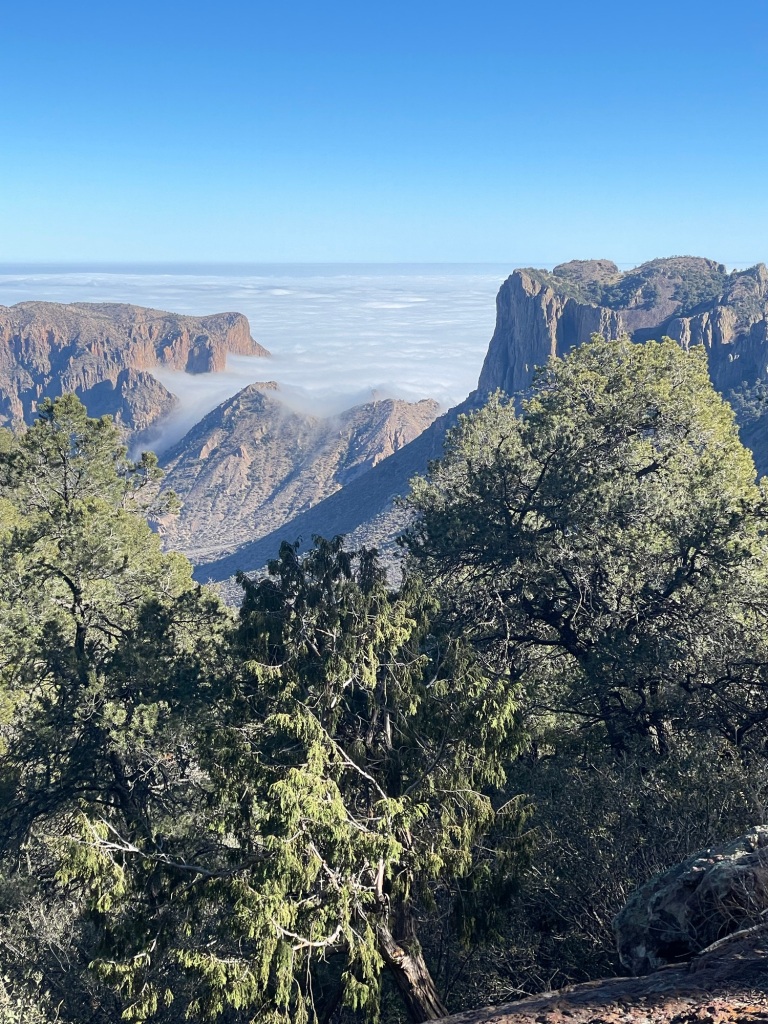
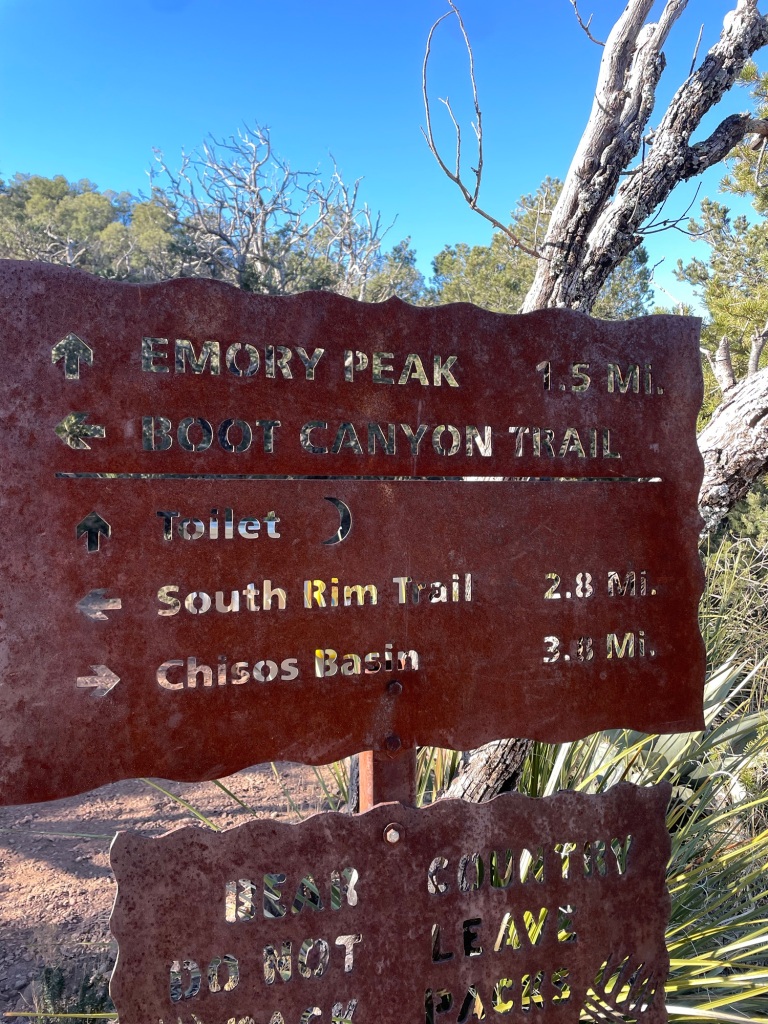
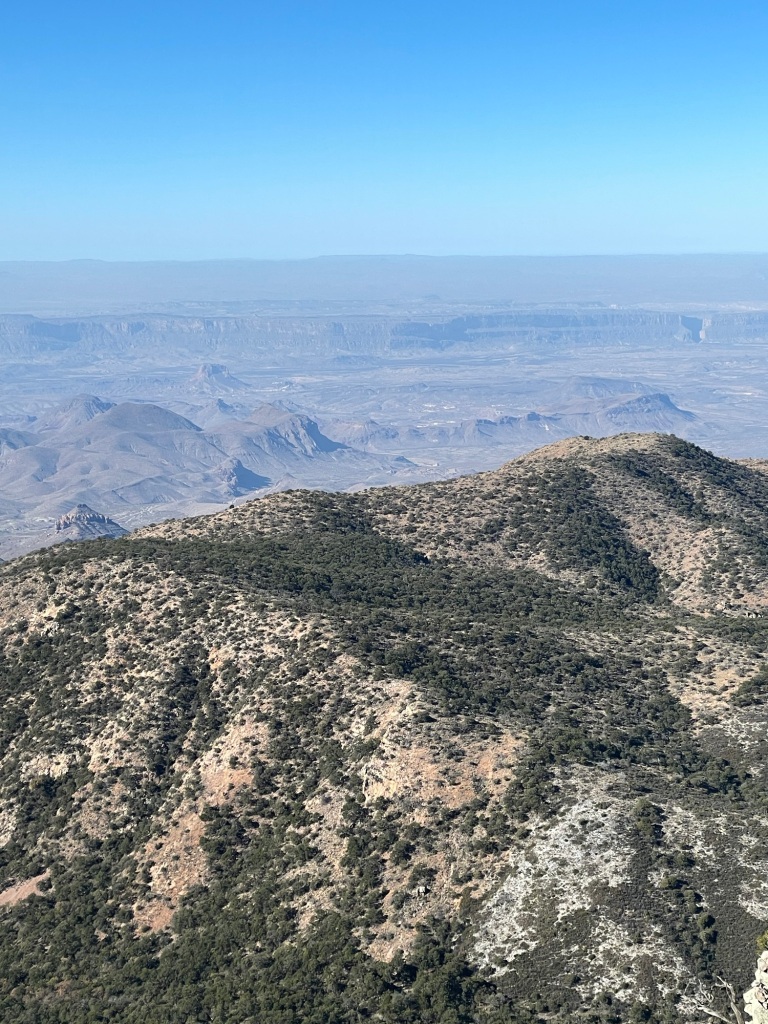
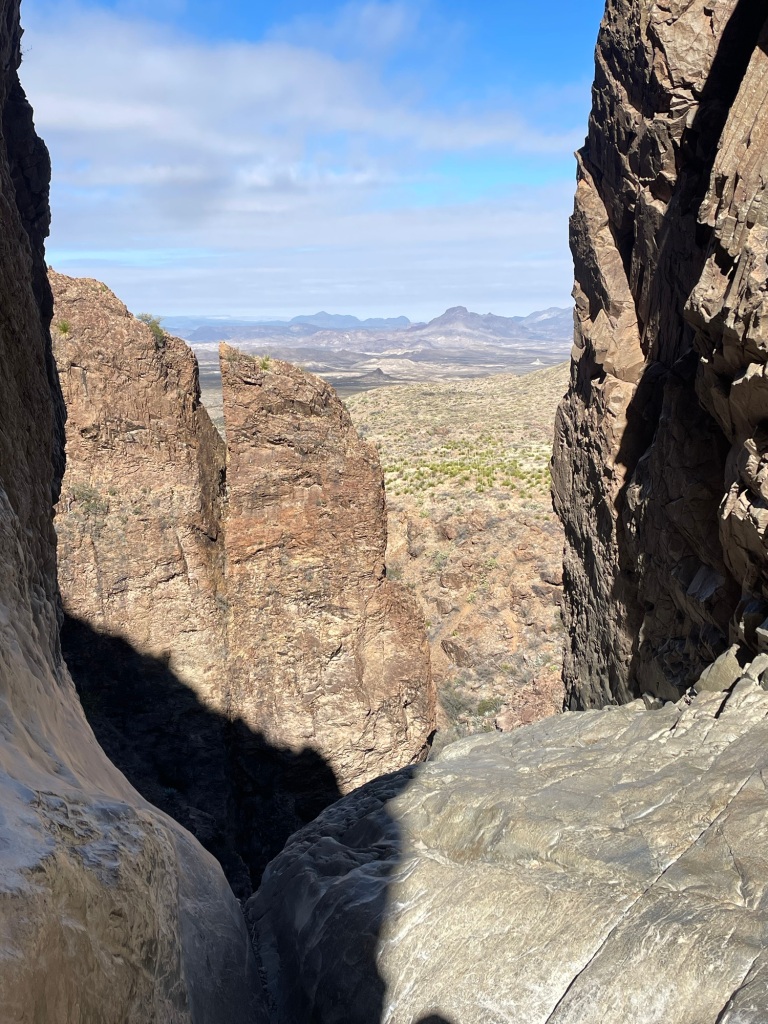
However we had time for one last hike on the Window View Trail which is accessed directly from the campground, so we were like a 30 second walk to that TH. This is a pretty short trail that goes to a very cool feature. The trail ends at the top of a waterfall. note that the rock is pretty polished, so even when the creek is dry test your footing as you approach the edge. It is a pretty short trail, but note you descend down to the waterfall, the return is a climb of about 500-600 feet of elevation gain that’s pretty much sun exposed. So if it is summer, carry copius amounts of water and consume it. We made it back to the campground around noon, so with that we decided to head on out of town to cut our drive time to Guadalupe down.
Big Bend was pretty damn impressive. I would totally return there, especially with the backpack and check out the South Rim loop, (note that from Feb thru April that trail is closed because of Falcon nesting). It would be fun to put together a 5-6 day loop, during the new moon to really get that star gazing in. I will note, that while this area is good for stargazing and I had some great dark sky nights I still find the skies in Nevada to be darker and clearer. If Big Bend is on your list and you have the time, doing a 7-10 day trip is very possible spending 3-4 nights in each of the three campgrounds. While we never made it to the Cottonwood campground, what I can say is that Chisos vs Rio Grande Village offered two completely different experiences and moving between them was super easy.
A few remaining shots of some sunsets, and random wild life.
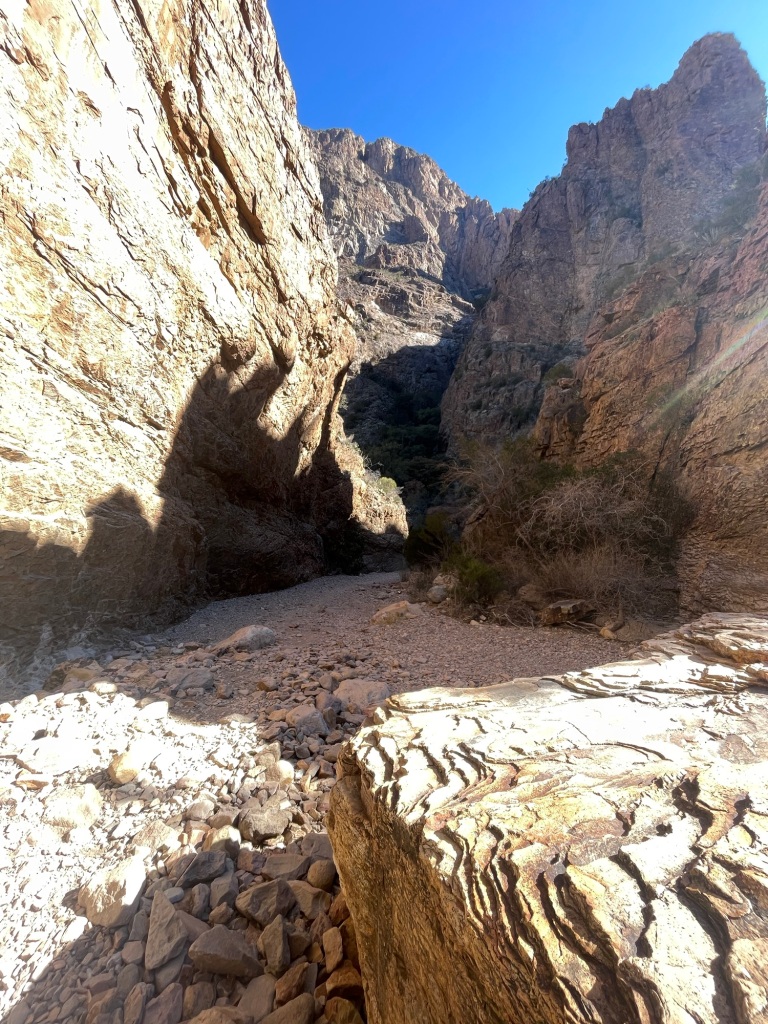
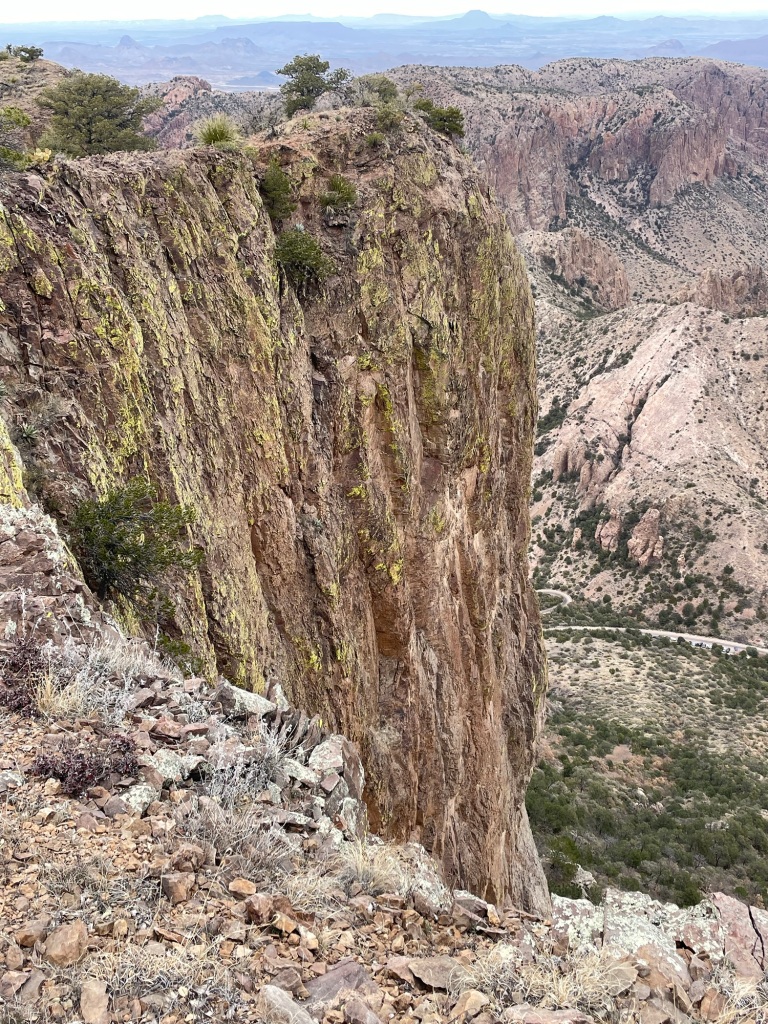
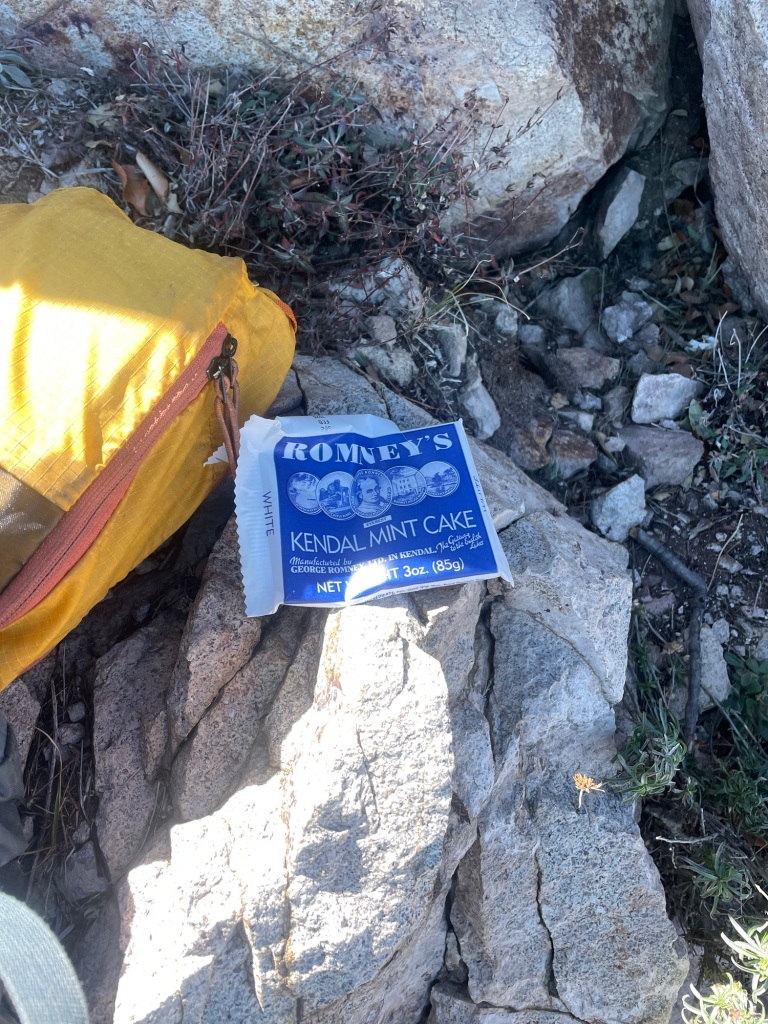
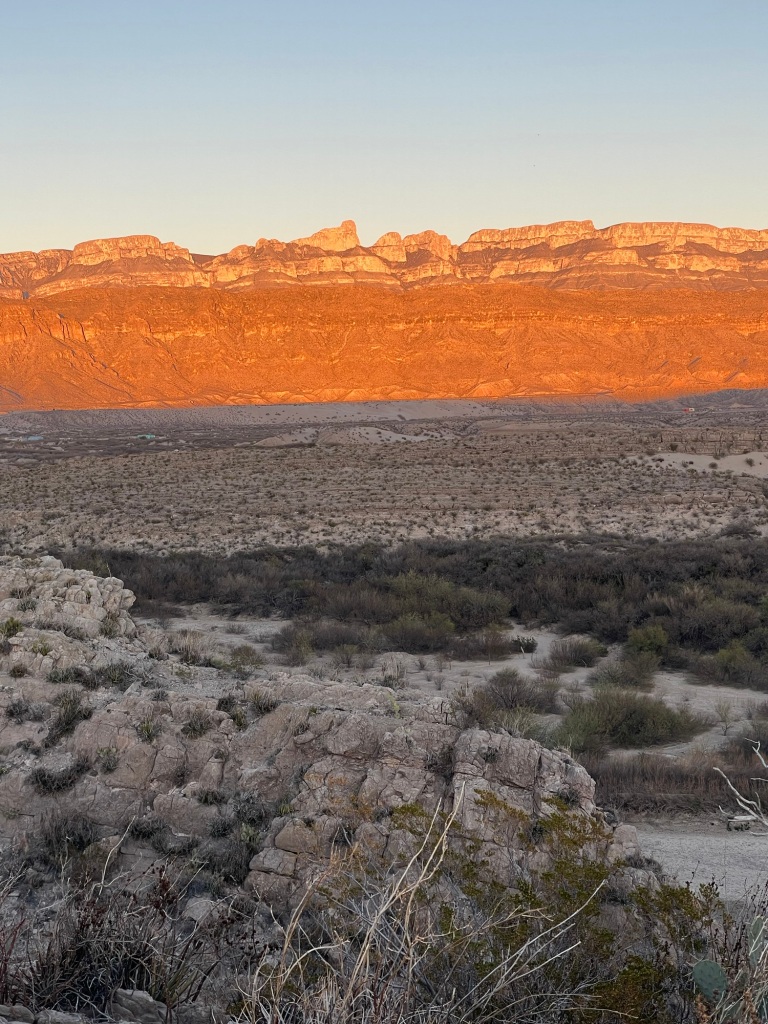
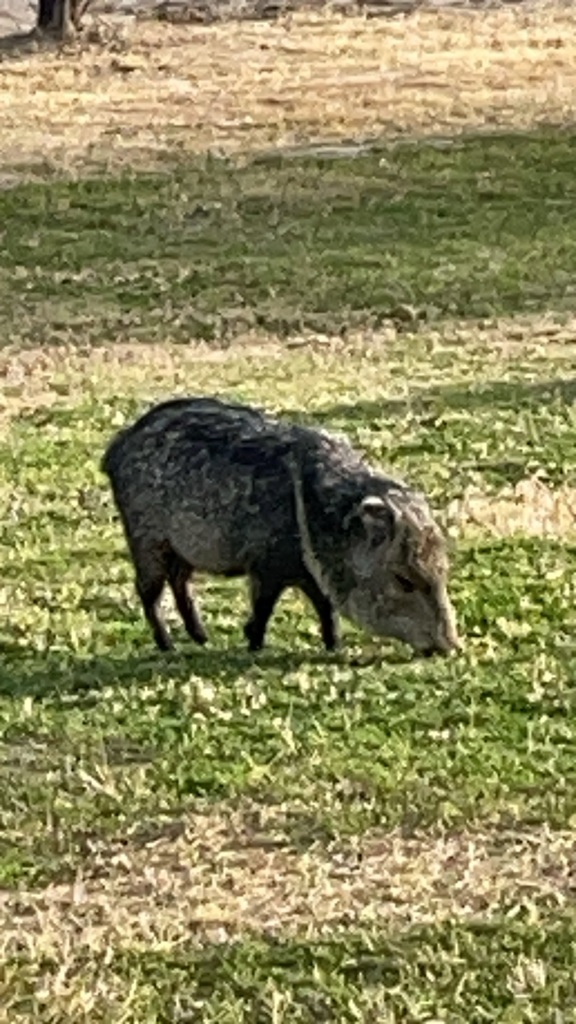

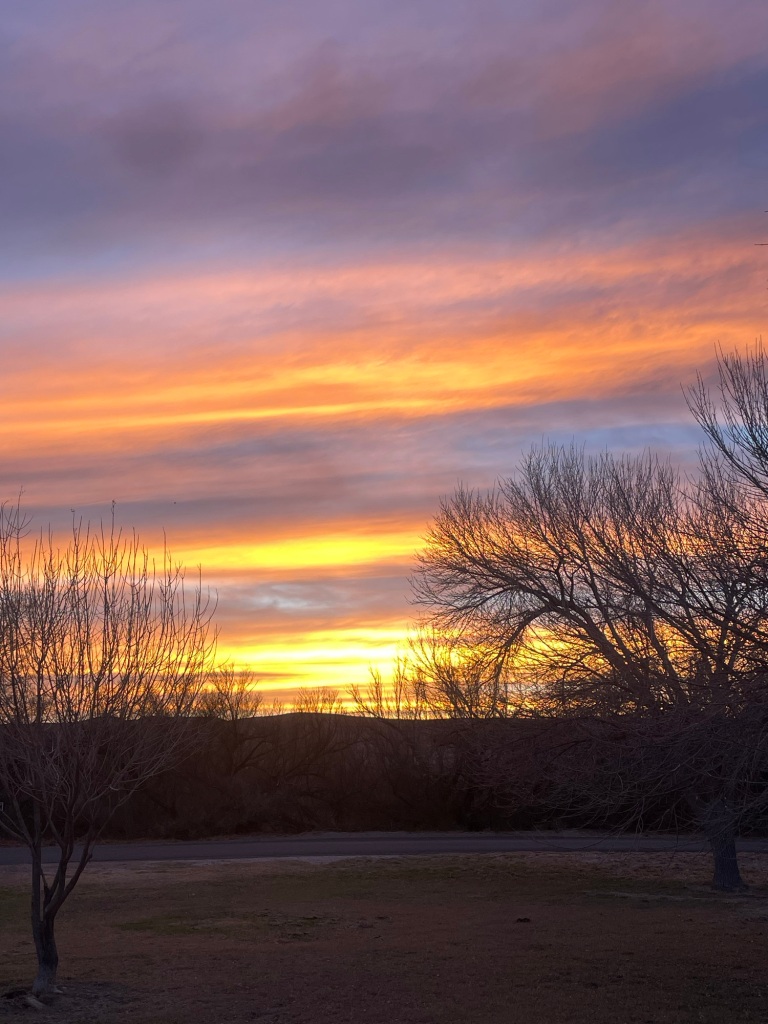
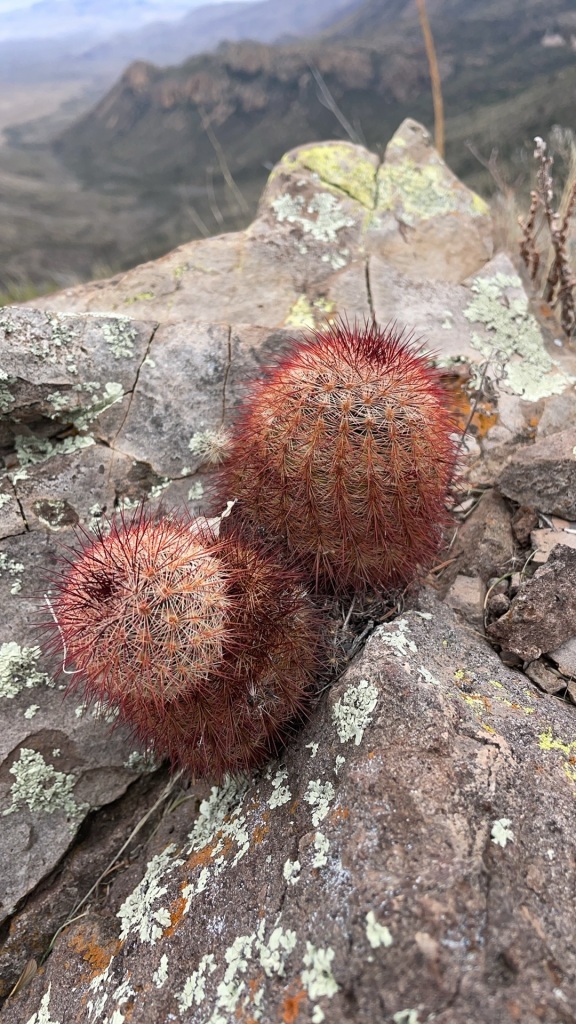
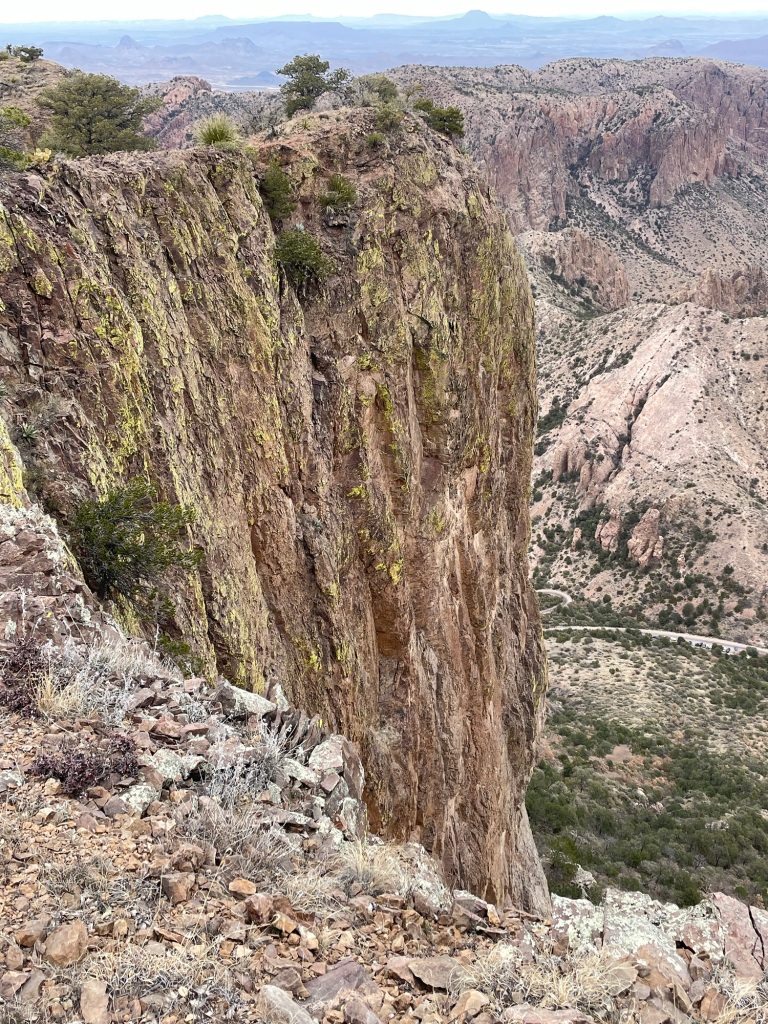

Up Next: Guadalupe Mountains National Park, and the Texas State high point.
Over the next few months I will be rebranding this site more inline with my other social media presences. Summits on the Air was a lot of fun and got me out to some very cool places, and really helped me further hone my planning and logistics skill sets, but the qsos do not have the magic for me they once did. Crazy too if you think about the fact the solar cycle is finally starting to heat up again. My last few activations only slightly moved me, and the desire to just walk is pulling pretty strongly for me now. I will be following up post rebrand with a write up of my recent Coast to Coast UK walk as it was a lot of fun. I may get out and do more SOtA, I have a house sit in Switzerland in about a month so I will reassess how and where SOTA may continue to play a part in my outdoor adventuring.
73 for now. de N6JFD/P
Time for a new chapter in life, so saying goodbye to Tahoe and seeing what the world has to offer us as I venture down a new career that will keep me walking in the mountains and allow us to travel!

Okay so this post is a bit of a one off that long term may not be a one off, although if you follow me on Instagram and saw how I rebranded there some of this will make sense. Note that I may eventualy rebrand this blog as well. Also this write up is being finished six months after I had intended to post/publish so this is a 6 month old draft that has both reflections and steady state of my where we were mentally in April 2022, as well as “wow that did not go as planned but OMG we had so much fun and the path is constantly fluid”.
What started this life altering event?
The story goes like so: It was Presidents day weekend (Feb) in 2022 and after seeing the house behind us sell for a ton, as well as the house across the street sell for more than it should have plus having a hunch that some big global things were about to hit (this was a couple of weeks before Russia invaded Ukraine) and an overall nagging feeling that the housing market was not sustainable for another year the wife and I decided to pay our financial guy a visit and to gauge how much we really needed to sell the house for to just walk away from the tech industry and take a little time to just figure things out as well as do some travelling. Thanks to the pandemic and folks looking to leave the cities and head to the rural areas we had watched our home value just sky rocket a lot over the past 18 months.
So with a number that kind of surprised us (lower than expected) and the desire to dip our toe in by asking for something that split the two houses I had mentioned above we ended up selling our house in 3 days for well over asking. Truth be told we were the last house in the area that was going up for sale that had a boat dock, and the guy that bought it had missed out on the house across the street; he did everything he could to not miss out on our house. This all happened so fast we had not had much of a chance to really start a plan other then establish new state residency in Nevada for tax purposes and start thinking about about some of the places we would like to visit. So what allowed us to be able to go from living the typical American lifestyle of humble but respectable house, good job, involved in the community blah blah blah? Well the main thing was both our children were now adults and were starting thier own lives and while our house was big enough (about 2000sq feet) for the 4 of us it was just to big for empty nesting. I had been constant in my mantra that i did want to be out of tech and working towards a job in the outdoor industry by the time I had reached 50, so now made the perfect time to take advantage of the situation and well “move on”. Things were just lining up perfectly, so what if we did not have a plan?
Okay so pretty quickly we decided that downsizing was in order and we did our best to give away, sell or just throw away as much as possible and we did pretty good with that. I donated all my Search and Rescue stuff (that was still usable) to the local SAR team I had been a volunteer for over the past 9 years. The end result of our efforts was we were able to put the last remains of what we deemed neccesary (clothes, and some stuff for the kitchen) into a 10×10 with enough room left over our Son and my mother-in-law could also move some stuff in (honestly we maybe take up like 15-20% of the storage facility) and could probably downsize to a 5×5.

We were gone from Tahoe by the end of March <sniff> <sniff>
Other than what I noted about “get a job doing something where I could be outside all the time”, the plan was come up with a 3-4 month travel plan and regroup later this year. So on April 30th I was “retired” from the technology industry. I deleted my LinkedIn account the very next day.
New Beginnings (a short stay in Reno): (these next few paragraphs are definitely mixing old and new). I have spent many years volunteering, and some side hustling involving Search and Rescue, or other wilderness education and leadership endeavors. It has always been my goal to find a way to do that as a profession, or even semi-profession; so anywhere we end up will have to offer some kind of guiding, teaching beginning backcountry travel or even some outdoor therapy. We are hibernating for the spring in the Reno area so maybe I’ll finally get a few of those North Lake peaks I’ve been ignoring, but after that we are hitting the road. We plan to spend some time down under with some friends, so hopefully I’ll be picking up one of the ZL associations, and spend a couple of weeks in Australia so I’ll get some more VK action too. Later in the year we will be headed to the UK and EU, I’ll be doing the West Highland Way (SOTA edition) in September and the wife has agreed (or well she decided for us) to do a little jaunt in the Lakes District called the Peaks to Pubs in August (if that’s what it takes to get her to do some walking with me so be it :D).

I do kind of want to reflect though on my time in Tahoe. I would like to throw out that reality is I lived my best life in Tahoe. I learned how to take care of my broken body in ways that living in an area that was not a mountain athlete focussed area would not have been possible (so I say to myself). I’ve always been a hiker and backpacker, and thanks to SOTA I did more hiking then anywhere else we ever lived; because of a trip in 2014 to Kilimanjaro and the back injury in 2013 I also learned the value of very regular working out and using someone to help me achieve very specific goals to keep me moving mostly pain free. Also just the amount of giving back I was able to do as a 9 year volunteer for the local SAR team. I spent the last 5 years in a leadership position within SAR, the teaching/volunteering for the local college teaching backpacking etc. I was definitely enjoying that whole aspect of my life. So yah, “best life we could live, why leave?” For starters we just no longer really enjoy (or our bodies do not) the snow any more. Despite that the winter of 21/22 was pretty mild, my body hurt a bit more than in years past, including those heavier snow years. Not that I am a weather wimp, but I do love hiking in green landscapes and sunshine :D. Tahoe had become routine, and I hate routine. My exploring was requiring further and further drives into NV/OR/UT just to get to new launching points, so it was time for a new base station. Those are just a few of the drivers to why it is time for us to leave this mountain town and try and find a new one. I am hoping we can find something that is less touristy, a bit cheaper but still offers access to water and mountains and exploration!
I will still be doing plenty of SOTA, but I will probably be operating with different variations of my callsign over the years to come.
(Jump ahead to May)

June had already been planned out. We were going to do a little travelling back east, and then I had some volunteering the last two weeks with a youth outdoor therapy group in the Truckee area (Gateway Mountain Center/GMC). A couple of weeks after my last day in the tech industry I get a phone call from GMC to confirm my volunteering, but the person on the phone was all apologetic about not getting back to me sooner because they had been franticaly trying to hire their full time guides for the summer months. “Oh really, you dont say? Well what are you looking for ?” The individual went through the list and so I replied with “Well my situation has changed some and I could actually take on a larger role with GMC”. (meanwhile in the other room I could hear an exasperated WTF sigh). After a couple of phone calls over the next couple of days what would have been a two week volunteering session turned into a five week stint as a guide.
Okay so lets touch on the “exasperated sigh”. Michele did not speak to me for a couple of days and I obviously knew why. Two weeks into retirement and I am already changing the rules. (two good rules for a successful marraige, communicate and never goto bed mad. I broke both; time for damage control). To be fair I was worried that waiting 1-2 years would have an impact on getting that first job in a new industry, and I was adamant about never working behind a computer ever again so to me it was more about getting a foot in for the sake of the long game and not risking losing the contacts I had developed at the college over the past few years. During the next couple of night wanders/dog walks I racked my brain to come up with the right things to say and a possible solution. After the second night and about a 3 hour walk I had it. In 2020 Michele was supposed to take her mom to Paris for a week, do the Disney thing and some fun touristy stuff, blah blah, but yah 2020 we do not need to revisit that :P. What I came up with was after our June East Coast trips were done, head to San Diego and Michele would reconfigure for a few months of time in Europe, take her mom for however long she can stay (I also planted the seed with my mo-in-law to kinda help things along) and I would catch up <somewhere> when the summer guiding was done. Within a few days the new plan was put into motion, plane tickets were bought and we were starting about to head off into our June travels. Note that during our time in Reno we also consumed a TON of videos on “how to behave like someone who was not quite “F.I.R.E”, but living that way. We also watched a bunch of expat videos, best countries to retire in videos, just whatever as we were not sure if we were going to Expatriate, stay in the US, or just travel. We also came across this very interesting service called Trusted Housesitters which we were planning to use as a way of finding stays in out of the way places and to help cut some costs on lodging. I had this wild hair about living out of our Audi AllRoad for the duration as I saw it as a fun experiment in further minimalisation. So my “reconfigure” was taking just what I needed for guiding and living in a medium sized wagon. It was a lot of fun at the end of the day!




My first night back to the area I drove up Monitor pass and camped at the gate on the dirt road to Leviathan peak (near Topaz on hwy 89). It had been a couple of months since i had experienced quiet and this area was QUIET! It was soo nice to be back to one of my favorite zones to go hide! So not a lot for me to hit on with my job other then to say I had a ton of fun, and finally felt some real emotion again. This was in fact the work I want to do and I do jive with a lot of the mindset of the organization. I did a pretty good job endearing myself to the founder and ended up taking on a lot of responsibility other than just guiding. Given that we were based out of Donner Summit I spent a combination of nights between sleeping at Rainbow Bridge as well as playing “Jack Torrance” at the lodge GMC bases their operations out of. It was nice being in this position and it allowed me to help in ways beyond just being a guide, but yah I guided a lot and had some very interesting experiences with the youth and chaperones I was working with, but well this is not the point of this post other than to say going down this road was a very worthy left hand turn to the road we had originally pulled on to a couple of months earlier.
On the road and a new path started: Fast forward to August; after guiding was done for the summer I spent a little time with Jeremiah down in San Diego and reconfigured for Summer and Fall travel abroad in Europe with the inclusion of some backpacking gear as I was doing a few jaunts while Michele would fly back for a softball tournament in late September. Michele was working the trusted housesitters thing well having done Bruges and Amsterdam on top of her travels and sits in Northern France. I caught up to her in Brixton England. Remember how I noted the house sitting thing *should* allow us to visit some places that might turn out interesting, but also be out of the way? Brixton is both the birthplace of David Bowie and was the cite of a riot in 1981 that was commemorated in the Eddie Grant song “Electric Avenue”. Brixton’s history and cultural influence was very Caribbean in nature, however the past couple of decades of gentrification was starting to have it’s impact. So the point of this next bit is not to highlight every little house area we hit, but to illustrate the need for flexibility and fluidity especially in view of our desire to just “travel” with no real plan overall. Okay I lie, we did have a couple of specific locations planned out. We knew we were going to do a house sit near Cognac France the first 3 weeks of October, and I was doing the West Highland Way the last two weeks of September, but for the most part it was a “lets hit the last few places in England on our list and just wing it”. We did rent a car for about 10 days but we mostly slow travelled via the trains. In the first six weeks we were together we visited James May’s pub in Swallowcliffe, Diddly Squat farm shop (we actually went here twice), went back to Wells yet again, visited Port Isaac for the whole Doc Martin thing, and did other house sits in Looe (Cornwall), Lindfield and Monmouthshire. We did have to sprinkle in a couple of AirBnBs here and there as well. One in Pembrokeshire Wales that allowed us to head to the coast daily for some fun coastal walking!






You can go read the write up on the West Highland way later on, and I should do a write up on the week between sending Michele back to the states and me doing some hiking in the Lake District and in Wales but for the sake of time on to France.
France was a lot of fun, we explored Fontveraud Abbey, Cognac and a lot of the area around the house we were at. The Tawny owls were amazing as I had owls every night when I would go and wander. It was very nice being out that far in the country. I was really enjoying being on the road and just seeing what the various locations would open up for us. I managed to sneak in some SOTA in the Pyrenees. I did have to cut my part of this sit a week short however. Back in late August I secured a spot at a week long interview/field training with a Youth program in North Georgia. This program was quite a bit different than GMC and ultimately at the end of the week I opted not to take the job. I was just not ready to “come in” off the road, however it was totally worth it to end the travels after 3 months (for me) to at least find that out. We are finishing up a house sit in the Washington DC area, and are headed back to the West Coast for Nov/Dec. I did pick up a couple of weeks at GMC in Nov/Dec but we also want to sit down and review a few things and build a plan around Australia/New Zealand in March/April/May (their Autumn).
Key Takeaways and things learned: Fluidity matters. Oddly enough after bouncing from a couple of house sits in France, Belgium and Amsterdam in July while I was working Michele really took to this notion of “do we really even need a home base?”. To the point that during her Sept visit to the states she ended up buying us a used Ford Transit Van for travelling and living in. It does look like I will keep working for GMC over the next couple of summers. We have tossed a few ideas around maybe doing a tour of all the National Parks, and sprinkle in some campground host volunteer/work here and there. The Van does open up a lot of options for when we want to be in the States. The problem with this kind of freedom is for everything you want to do you really do need to pace yourself which leads me to my next thought.
While I love the notion of just winging it, it does help to have some type of plan, or at least a few destinations in mind. It is very easy to get around in Europe and just walk. I love to walk and I love to explore and well the radio thing helps too :D, there are pathways everywhere, and just so much history. For every location we stayed in there was no shortages of nearby hikes that had a story. I even added the GR10 to my wish list of long walks I would like to do. I also committed to a friend of mine who really wants to do the Portugeuse Compestella next fall.
It seems impossible to find small houses for a couple, it seems society has deemed it that if you are an empty nester you need to be moving into one of those over 55 condominium villages. Most of the neighborhoods we looked at on realtor.com seem to mostly have 3000+ sq foot super mansions, no thanks, not our lifestyle..too much to clean, and too much to heat/cool.
So for now as noted, we are going to play in the van and build a plan for our Spring travels to the Southern Hemisphere as well as the fall travel back to Europe. Central/South America and Africa are also down the road too. We are thoroughly enjoying this minimalist mindset and this whole “home is just whereever you happen to be at that moment in time”.
Teaching and mentoring is my bag, facilitating is okay however when it does come to executing the therapy program that is being written by a therapist/psychiatrist for a specific individual I tend to lose interest. I love the idea of teaching backpacking skills so I will try and dip my toe in that world as well. It might be fun to find someone who can hire me to do that internationally. Guiding the JMT, WHW or TRT could be pretty fun!
We always seem to end up in England so we agreed to take a 3-4 year break from winding up there. 😀 I love the Lake district for sure, but after my little jaunt in the Pyrenees and the time I have spent in the Alps and other trips I do have planned, it’s just time to stop going back to the old familiar and see what all these other mountains in the world do have to offer. I want to see if those mountains talke to me the same way the Sierra Nevada does.
For now I am going to say 73 and there will be more coming later on down the road.
de N6JFD
So as I called out in my last blog that the 30m QCX test was a success. In 25 minutes I had 10QSO before my battery died. You may recall me commenting that during the hike out, I was wondering if I could somehow reduce the weight and some of the additional hardware by using just the inductor and capacitor and direct wiring into the PCB on the QCX. QRPGuys makes a mini version of their single band half wave EHFW: Enter the QRP Guys Mini NOTune Half wave EFHW. Finally having a night I can work on it I set out to get as much as the matchbox part of the build done. First up, time to remove the BNC adapter on the QCX:
 For the sake of giving myself some options down the road I just snipped the leads off the BNC adapter, and then carefully worked the anchor studs out.
For the sake of giving myself some options down the road I just snipped the leads off the BNC adapter, and then carefully worked the anchor studs out.
Next up it was time to work on the plastic enclosure for the antenna and get that prepped. I actually like that the matchbox they supply with the kit is not pre-drilled. This gives you some options, or more over, does not mean you have holes to plug if your intentions end up similar to mine.. I did not drill the big hole for the BNC connector obviously.
The instructions are pretty straight forward on this and I had the solder work done within an hour. One thing I’ll call out now is that the QRPGuys mini is the same height as the QCX enclosure, so it wont look too awkward.
Midpoint check-in: 
Thinking that I was not going to be using the BNC adapter hole I thought put the main antenna out one side, and the counterpoise on the other. That later ended up being a mistake because the screw stub was now covering the 3.5mm jack for the key. Whoops, one more hole I now have to fill. Maybe this is why I should not work late ;).
After jamming some John Denver most of the night, I got to the point that my next step was drilling into the enclosure and given it was past 11pm I opted to wait till morning, and took advantage of a mid morning break between meetings.
<The Next Day> 😀 Marked the holes on the enclosure, pre-drilled with a bit that was about the same size as the supplied self tapping screws, then hit the enclosure with a step bit to go just a touch wider.

Sweet, the mounting holes were lined up perfect, and the wires come thru with plenty of length. After this I put some electricians tape around the inside of the opening to keep wire/metal from touching the enclosure. I unfortunately did not have any clear silicon caulk, and was too lazy to head to the hardware store, so I opted to use some white latex/tile caulk that I had around. It is just a temporary thing, but the goal was to have some sort of seal between the enclosures. Oh and to also seal up that extra hole I put into the antenna matchbox. It’s ugly and you will see that down below., but for now it will get the job done.
At this point I went ahead and re-added the QCX into the enclosure, secured it on two of the mounts for testing, and then soldered the new connections to my antenna nubs. I then plugged in the battery to make sure it still powered up, and was still getting the same power out, and voltage in readings it was before. No smoke and the numbers looked good :D. Might as well go ahead and see if this setup actually works, so borrowing the radiator off the PCB version of this antenna I ran out to the meadow behind the house where I do my testing from. W00T: Success: After a couple of run thrus of the pre-recorded test cq message I setup a while back I was picked up by VE6WZ which is about 900 miles away on the RBN. Not bad given this QCX with its current setup/battery puts out 1.85W of power. For those that do not know, apparently the build specs on the 30m QCX are a little off for inductors L1 and L3, most folks who have offered feedback suggest changing those inductors to 16 turns and not the 19 it calls for in the instructions. I have not yet done L1 but I did do L3 which did boost power a little. Inductor L1 is in a weird spot, and I am not sure I want to deal w/ the headache of re-attaching it once I get one side off. Besides from a summit, 2W is plenty of power, and given the RBN did pick me up from the Tahoe Basin I call it a success as is.

Yes that white caulk is ugly, I’m thinking I’ll scrape that off and redo with a clear silicon. I also ordered some new 22awg wire for the new radiator in a different color. The yellow one is a little bit short, but I know that radiator on the PCB version of this antenna is resonant at 10.118 and I will still use that antenna with my KX2.
So now that everything is back together, I took and weighed the entire kit as I will carry it to a summit. It is coming in at a whopping 1lb 2.2 oz. The kit contains: palm pico paddle, small ear buds, 1400mah battery, MSR mini-hog tent stake to secure the far end and of course that QCX. A pretty simple rig for those days where I want to go far with minimal weight, and get there quickly. Next modification maybe to go with a touch sensitive keyer. Find a way to build a battery into the enclosure and the only *extra* stuff I’ll be carrying are the headphones.
I’ll be testing this out on a live activation this coming Saturday. Anyone want to buy a KX2? (seems like 30m and a 2m HT will get the job done for the most part, at least in the areas I like to activate from. Not sure I’m ready to sell the KX2 yet, just kidding, I do chase from home with the KX2.
Speaking of QSOs, I finally got around to designing and then ordering some new QSL cards. I intend to start shipping out QSL cards as response to ones received over the past couple of years next week. Better late then never :D. What prompted that decision was in a matter of a couple of weeks I received ~10 QSL cards because I had been making some new contacts, including some with IOTA folks. I like getting them, only fair I should respond in kind. I went with qslpostcards.com because a few of the QSL cards I’d received over the years had their URL somewhere on the card. The quality of the ones I’d received seemed pretty good, and they were a good price. (250 cards for $69.00). I like supporting small businesses too and these guys are HAMS. Those finally came today.
That is all for now, hope to QSO you from a summit in the future!
72 de N6JFD.
Here it is towards the end of April, spring is in full swing in some areas, however the Sierras are still coated with feet of snow, but the mountains in NV are calling and open with easy access. So for the past two years I have been operating with a KX2 and that is an amazing rig, full of features, and I am sure i am only scratching that surface, and my kit weight has varied over that two years as I have added/subtracted batteries changed up antenna configurations etc, but it does come in around 5lb.
All that said last year I went thru level 1 of CWops and started doing some CW on my activations. I immediately went from hoping to get 10 contacts, to always getting more then 10 contacts when I started doing CW as the bulk of my activation. I’ll still hit some 40m SSB because some of my friends still are SSB. Why I brought up old news, is that going to cw opened up 30m for me, and on those weekends when 20/40 are in use for some contest, that can make an activation a bit more challenging. What I have found with 30m is I still get the same chasers I do on 40/20, but the signal reports are not as strong, with the exception for W5N, and W7A which are stronger. W7O is down in the 3s and W7W is in the 4s for me and I can consistently hit W0C. While I am not saying 30m will always get me the most number of contacts all the time, it will at least get the job done, and the regular chasers will do their best to work you, especially if they know you are mono-banding.
About this same time the NASOTA slack channel really started to grow. A few of those fellow SOTA folks are kit builders, and love tinkering with their rigs etc. K6ARK has added a touch sensitive keyer directly into his MTR3b as an example, since then he even built a micro-pixie with built in matching unit and direct attach end fed for a SOTA capable rig that he has used on an activation that weighs in the 3oz range. KT5X out in NM is always looking to make a lighter kit as well, and often writes the NASOTA groups.io forum with his updates. KE6MT has also been a fountain of information on the builder front and has helped me immensely (he better, I’m his associate association manager ;P ). That said, I took it upon my self to order a 30m QCX (from qrp-labs.com) with the intention of using that as a light-weight SOTA rig on those days where I want to do a lot of miles, and I may be shooting for a lighter pack to focus on miles while still carrying the 10essentials, or I am time limited. The Black Diamond Distance 15l fills the bill well, and I used it on a recent co-activation with Rex on Waterhouse Peak. Maybe I will be one of the first SOTA guys to do an UltraThon AND an activation on the same event. (doubtful, but one can dream).
That five pound mark is not too bad overall, and I know folks who carry more, and even with that list, there are some changes I could make to get it lighter yet. End Feds are great just draping off the side of the mountain as a “sloper” and in some cases, some peaks already have things you can use to help go inverted vee (like tree limbs or no longer used antenna towers). So I can drop the fishing rod all together in the future.
I have set my goal to be less then 2lb overall because I have a few hikes I want to try as a “HaRunk” (ham radio trail run). So I have set out on how to accomplish this mission, enter the QCX and a new kit
 I have chased a few folks with the QCX from the QTH, but now it was finally time to use the QCX as my activation rig. It was on Easter Sunday and on a day that 30m propagation was not great and I was not on summit till noon. SotaWatch showed that I was the first spot in over two hours. I managed seven QSO over 25 minutes and then my battery decided it was time to shut off for recharge (oops..been testing a lot, forgot to check levels). Either way it was a successful activation on a unique summit. Full disclosure it was also the first time I have done an activation without using the decoder, and I managed to get a good copy on all those who called me whom I could hear, so I am getting better there too. Contacts included: AG6VA, K0RS, KR7RK, W7USA, WA9STI, W7GA and K7RJ. According to RBN I was reaching the VE6WZ beacon up in Calgary, approximately 700 miles. Last time I checked, I was putting out 2watts of power, but that was before I really tuned my EFHW. On the approach drive in *4×4 road* I managed to make it to within a mile of the summit, but overall this is a drive up summit. Either way, b/c I am in run training, the 1 mile 400 foot elevation just helps with the training, and I do my best thinking when I’m walking (more on that below). Those structures you see on the summit proper are from past deployments I think, all the radio towers, cell towers, and TV towers have been moved to other nearby peaks, overall (at least on 30m) this was an RF quiet peak.
I have chased a few folks with the QCX from the QTH, but now it was finally time to use the QCX as my activation rig. It was on Easter Sunday and on a day that 30m propagation was not great and I was not on summit till noon. SotaWatch showed that I was the first spot in over two hours. I managed seven QSO over 25 minutes and then my battery decided it was time to shut off for recharge (oops..been testing a lot, forgot to check levels). Either way it was a successful activation on a unique summit. Full disclosure it was also the first time I have done an activation without using the decoder, and I managed to get a good copy on all those who called me whom I could hear, so I am getting better there too. Contacts included: AG6VA, K0RS, KR7RK, W7USA, WA9STI, W7GA and K7RJ. According to RBN I was reaching the VE6WZ beacon up in Calgary, approximately 700 miles. Last time I checked, I was putting out 2watts of power, but that was before I really tuned my EFHW. On the approach drive in *4×4 road* I managed to make it to within a mile of the summit, but overall this is a drive up summit. Either way, b/c I am in run training, the 1 mile 400 foot elevation just helps with the training, and I do my best thinking when I’m walking (more on that below). Those structures you see on the summit proper are from past deployments I think, all the radio towers, cell towers, and TV towers have been moved to other nearby peaks, overall (at least on 30m) this was an RF quiet peak.
When I started tinkering with the idea of a single band antenna I went and snagged a qrpguys NoTune end fed HW antenna. I was still lugging that big 4.5mah battery, so I am thinking next up there will be to go snag an 1800-2200mah LiFE/LiPo battery; that should give me 3-5 hours of operation overall. Weight difference there is almost a pound. I love having that mono band EFHW antenna, but I was concerned that banging the PCB around on rocks, or letting it hit snow, or snag on a limb could be detrimental. While I was hiking out, it dawned on me, that all I really needed from that PCB is the transformer and capacitor, and some way to shove it inside the QCX enclosure or protect it another way. I actually went back to the QRP guys page b/c I’d heard rumors they were making a self contained matchbox version of the same antenna, and sure enough they have a mini version. Purchase complete, hopefully here by the end of the week. That actually helps me solve a couple of issues as I can use the matchbox to cover the opening that removing the BNC from the QCX will create. I will also be able to use that to wire the components direct to the QCX PCB. (I am just a rookie at the tinkerer thing, so things will probably look/be clunky at first). I will have to plug the hole on the matchbox for the BNC, so a new problem to solve, but not major. Honestly the best outcome is to somehow figure out if I can get the full setup inside the QCX enclosure, and then tap two screws for counterpoise and antenna thru the enclosure. I will also be able to roll the wire (42’6″) around the QCX case as a winder. Moving to this will also eliminate the need for a feedline, or a BNC/BNC coupler and with lighter battery will help achieve that 2lb goal I am shooting for. I am hoping to have that all setup for the Lake District SOTA weekend in the UK, as I am looking to do some mileage on my first day over in Wales to snag Snowdon and YLlwedd before heading up to Ambleside. I may actually break it on Mt Shasta the weekend prior to heading out.
Once i get the new changes put in, I’ll start doing some power drain measurements and add those to a followup post. This is the part of SOTA that makes Ham Radio fun, the tinkering and playing and seeing what can be accomplished with small gear.
So let me re-iterate: I do not condone leaving the 10-essentials at home, but we always have room for improvement in reducing pack weight. Given enough time and creativity really coming up with ways to build a walkabout kit with SOTA gear that borders on featherweight on the back is in and of itself a fun exercise.
Get out there and enjoy the hills!
72 de N6JFD
So for those that do a lot of peak bagging in the Tahoe area you may have heard or read about the Tahoe OGUL list. “Ogul” is the Washoe word for Bighorn Sheep. That is kind of fitting since Cali/W6 has an award called the California Bighorn Ram
“The Bighorn Ram Award is available to those activators who have accumulated 500 points activating W6 summits.” –W6 ARM.
The Tahoe OGUL list is 63 peaks in the area of Lake Tahoe, Carson Pass, Ebbetts Pass, the Sweetwater range and a few others dotted here and there. Please note that not every peak on the OGUL list qualifies as a Summits on the Air summit. SOTA adheres to the P125 meter standard for prominence, and some of the peaks on the OGUL lack the prominence compared to other nearby peaks. Case in point Basin Peak and it’s proximity to Castle Crags, the prominence is only 337 feet and on the same ridge as Castle Crags. I will include those peaks as well just for the sake of keeping the list correct as it exists at the OGUL pages but the SOTA Ref will just say “Not in Sota”.
If you would like more information on the history of the Tahoe OGUL list by all means check out http://www.tahoeogul.org/. Summits on the air can be found at http://sota.org.uk
And now the table:
9735′ / 2967m
| Peak Name | Elevation | SOTA Reference | Lat/Lon |
|---|---|---|---|
| Adams Peak | 8197′ / 2498m | W6/NS-158 | 39.9106, -120.1001 |
| Anderson Peak | 8683′ / 2647m | Not SOTA | 39.2591, -120.2971 |
| Basin Peak | 9015′ / 2748m | Not SOTA | 39.3822, -120.3645 |
| Black Butte | 8030’/2448m | W6/NS-170 | 39.3950, -120.5579 |
| Castle Peak | 9103′ / 2775m | W6/SN-038 | 39.3655, -120.3492 |
| Desert Creek Peak | 8969′ / 2733m | W7N/TR-009 | 38.6139, -119.3160 |
| Devils Peak | 7704′ / 2348m | W6/NS-197 | 39.2824, -120.4406 |
| Dicks Peak | 9974′/3040m | W6/NS-068 | 38.9004, -120.1510 |
| Duane Bliss Peak | 8658’/2638m | W7N/TR-014 | 38.0806, -119.8781 |
| East Sister | 10402′ / 3171m | W7N/TR-001 | 38.5232, -119.2901 |
| Ellis Peak | 8740′ / 2664m | W6/NS-133 | 39.0684, -120.198 |
| English Mountain | 8373′ / 2552m | W6/NS-141 | 39.4463, -120.5510 |
| Freel Peak | 10881′ / 3317m | W6/SN-034 | 39.4463, -120.5510 |
| Genoa Peak | 9150′ / 2789m | W7N/TR-007 | 39.0430, -119.8813 |
| Granite Chief | 9006′ / 2745m | W6/NS-115 | 39.1983, -120.2868 |
| Haskell Peak | 8107′ / 2471m | W6/NS-162 | 39.6624, -120.5522 |
| Hawkins Peak | 8107′ / 2471m | W6/NS-065 | 38.7384, -119.8726 |
| Highland Peak | 10934′ / 3333m | W6/NS-033 | 38.5438, -119.7558 |
| Jack Peak | 9856′ / 3004m | Not in SOTA | 38.8905, -120.1542 |
| Jeff Davis Peak | 8990′ / 2740m | W6/NS-114 | 38.6366, -119.8965 |
| Jobs Peak | 10633′ / 3241m | W6/NS-047 | 38.8579, -119.8616 |
| Jobs Sister | 10823′ / 3299m | Not in SOTA | 38.8625, -119.8847 |
| Lookout Peak | 9584′ / 2921m | W6/NS-088 | 38.5107, -119.8730 |
| Lyon Peak | 8891′ / 2710m | Not in SOTA | 39.2068, -120.3157 |
| Markleeville Peak | 9417′ / 2870m | W6/NS-096 | 38.6617, -119.8979 |
| McConnell Peak | 9099′ / 2773m | Not in SOTA | 38.9485, -120.2430 |
| Middle Sister | 10859′ / 3310m | W6/ND-004 | 38.5080, -119.2952 |
| Mokelumne Peak | 9332′ / 2844m | W6/NS-103 | 38.5380, -120.0948 |
| Mt Elwell | 7812′ / 2381m | W6/NS-182 | 39.7082, -120.6883 |
| Mt Fillmore | 7715′ / 2351m | W6/NS-194 | 39.7302, -120.8525 |
| Mt Mildred | 8398′ / 2560m | W6/NS-142 (Same Ridgeline) SOTA pk is taller | 39.1460, -120.3300 |
| Mt Patterson | 11673′ / 3558m | W6/ND-001 | 38.4366, -119.3051 |
| Mt Price | 9975′ / 3040m | W6/NS-377 | 38.8641, -120.1743 |
| Mt Rose | 10776′ / 3285m | W7N/WC-001 | 39.3437, -119.9171 |
| Mt Siegel | 9450′ / 2880m | W7N/TR-003 | 38.8896, -119.5016 |
| Mt Lola | 9143′ / 2787m | W6/NS-111 | 39.4329, -120.3644 |
| Mt Tallac | 9735′ / 2967m | W6/SN-036 | 38.9060, -120.0987 |
| Needle Peak | 8971′ / 2734m | Not in SOTA | 39.2007, -120.3008 |
| Old Man Mountain | 7789′ / 2374m | W6/NS-184 | 39.3705, -120.5219 |
| Phipps Peak | 9234′ / 2815m | Not in SOTA near NS-105 | 38.9546, -120.1499 |
| Pyramid Peak | 9983′ / 3043m | W6/NS-067 | 38.8445, -120.1577 |
| Ralston Peak | 9235′ / 2815m | W6/NS-108 | 38.8333, -120.1015 |
| Raymond Peak | 10011′, 3051m | W6/NS-066 | 38.6040, -119.8333 |
| Red Lake Peak | 10061′ / 3067m | W6/NS-062 | 38.7142, -119.9873 |
| Red Peak | 9307′ / 2837m | Not in SOTA | 38.9254, -120.2214 |
| Reynolds Peak | 9690′ / 2954m | W6/NS-081 | 38.5793, -119.8377 |
| Round Top | 10380′ / 3164m | W6/NS-055 | 38.6635, -120.0015 |
| Rubicon Peak | 9183′ / 2799m | Not in SOTA | 38.9886, -120.1335 |
| Sierra Buttes | 8587′ / 2617m | W6/NS-139 | 39.5937, -120.6460 |
| Signal Peak | 7841′, 2390m | W6/NS-179 | 39.3390, -120.5352 |
| Silver Peak | 8930′, 2722m | Not in SOTA | 38.9347, -120.2306 |
| Silver Peak | 10774′ / 3284m | Not in SOTA | 38.5641, -119.7603 |
| Snow Mountain | 8014′ / 2443m | W6/NS-171 | 39.2412, -120.4639 |
| Snow Valley Peak | 9214′ / 2808m | W7N/TR-006 | 39.1538, -119.8830 |
| South Sister | 11339′ / 3456m | W6/ND-002 | 38.4824, -119.3001 |
| Stevens Peak | 10061′ / 3067m | W6/NS-375 | 38.7336, -119.9827 |
| Tells Peak | 8872′ / 2704m | Not in SOTA | 38.9600, -120.2545 |
| The Nipple | 9340′ / 2847m | W6/NS-102 | 38.6402, -119.9332 |
| Tinker Knob | 8949′ / 2728m | W6/NS-121 | 39.2448, -120.2851 |
| Twin Peaks | 8878′ / 2706m | W6/NS-128 | 39.1124, -120.2317 |
| Wade Benchmark | 9367′ / 2855m | Not in SOTA but near W6/NS-100 | 38.8166, -119.8425 |
| Waterhouse Peak | 9497′ / 2895m | W6/NS-092 | 38.7762, -119.9655 |
| Wheeler Peak | 11664′ / 3555m | Not in SOTA near W6/ND-001 | 38.4186, -119.2881 |
Yet another list of peaks I was aware of, but did not really bother to look into until I realized I have completed about 60% of these peaks (as of Nov, 2018) including a lot of the non SOTA peaks.
I may reach out to the Association Managers for W6 and W7N to see if a dual state list based award similar to the Tahoe Ogul pages, but SOTA specific is possible.
Hear you on the next one
73 de N6JFD.
Been a while since i have blogged about SOTA but I have still been getting out there (365 points so far this year). Part of that time though has also seen the usual increase in SAR activity. For those that do not know I am a member of a SAR team located in the Sierra Nevada. So this is going to be a soapbox post, more for the general public then for SOTA people, and most SOTA people seem to be in the know and I hope they are in the know! Still think this is worth talking about though as a nice break from a SOTA trip report
When you read an article in your paper/online whatever and it says “hey go check out this NOVICE trail” do a bit more search then what that article supplies. We’ve had 5 SARS in the past month at a trailhead we maybe see 1 SAR in a year at that this was a direct contributing factor. Oh I’ll pick on more subjects then just these 5, but we’re going to start here! It was nice that some local paper/news outlet/whatever covered a trail to help get some exposure for it (or maybe not since increased use means increased damage) but that should not be the end of it from a research perspective. In the case of this trail maybe ask yourself some other questions like… “This is in the Sierra, what is the elevation, have I ever hiked at this elevation before?” Will my cellphone and google maps/alltrails/gaia GPS/whatever map app you use be enough in an area that probably does not have cell coverage? Have I left a plan with someone? That is the one that most people miss. They do not leave a plan. What supplies will I need? sure it’s warm during the day, but at night, when it’s 50, 40, or even down to 30 degrees, if I do end up being over due will I be warm? Which leads me to my next question, do I have a light? do I have food, enough water, or a way to treat water if I pull it from the streams? That water may look cool, clear and tasty, but chances are if it’s in the mountains it’s probably had some marmot fecal matter in it, or donkey/horse where trail crews use pack animals to take supplies in etc. Unless you want to lose 20-30 pounds FAST, do not drink the water untreated!!! I will not recommend any product or what to carry beyond perhaps consult the 10 essentials. Oh and also, IF you are taking your pup figure out things like what is the longest hike I have taken my dog on? Have I ever had my pup walk on Sierra Granite? Maybe I need shoes for my dog? SAR teams technically are not allowed to rescue animals, some districts may try and fudge it via some other various justification like “the owner was not going to leave the animal, so the owner was going to put his/herself in harm”. Be advised too that if a SAR team comes to help you with your four-legged friend, IF animal services/Humane Society/whatever happens to be in tow there is a chance you might get cited for animal negligence (yes I have seen this happen first hand. That owner started crying b/c of the overall ordeal and this last minute surprise). Sorry but as an animal lover, I concur with AS’s action in this case. The owner should have known better. ” stated they had never heard of shoes for a dog”
So back on the weather angle for a second, and I think I have ranted on this particular group of subjects in the past, but the employees from a large technology company who own a mapping division who thought it would be a great idea to go bag a 9000 foot peak in the Sierras in January. They had nothing more then 2 16oz bottles of water each, no food, blue jeans, their company schotzky jackets, and IIRC one individual of that group of three was actually wearing canvas VANs shoes. If I really need to explain even a few things that are wrong in the above, do yourself (and your local SAR teams) a favor, and stay on the couch. Sorry if I am sounding elitist, but I’ve seen enough folks not using the massive lump of gray material between their ears that just asking themselves a few basic questions would have saved themselves some possible embarrassment..
So what I will recommend is that you at least understand what the 10 essentials are. I have heard a few people often refer to this as “some arbitrary list that does no good” and well there is some truth to that statement IF you do not know how to effectively use the items, you can technically survive for a few days with just these supplies.
What are the 10 essentials? https://www.nps.gov/articles/10essentials.htm
A Pack while not on the list, is needed for carrying this stuff, so might as well put this at the top of the list. They also do not list some sort of knife (I call out a multi-tool below) but I can do more with a 4 inch full tang blade for survival then I can with a multi-tool. (Full tang means the entire length of the knife is a single chunk of steel, it’s not a folding knife etc). If you have to cut on trees to build a shelter you will end up possibly breaking a folding knife etc.).
Navigation: A cell phone alone will not cut it. Even with external battery/recharge capabilities, you are going to be in some areas where you may not have access to a cell tower. (Sometimes you do need Data to pull that map down). A GPS unit, or even just a paper map is a good back up. For you weight weenies out there, paper is pretty darn light.. The important thing here is whatever your nav method, KNOW HOW TO USE IT, or it is basically trash in your pack.
SUN PROTECTION: Sunscreen, hat, sunglasses etc. This is pretty self explanatory, and I’d almost say the sunglasses are more important in winter then summer.
INSULATION – Jacket, hat, gloves, rain shell, and thermal underwear: The weather report may say “0% chance of rain and sunny” but the mountain does not always listen to the weather forecasters. The mountains are capable of making their own weather, and storms can come up out of no where. Even in the Sierras in the middle of July it can snow at night and if you are out there with nothing more then shorts and a t-shirt, you are going to have a long, cold, miserable night.
Illumination: Another one of those “and your cell phone alone will not cut it” items. I remember once i was backpacking somewhere and I was on a nearby peak to my campsite. It was nearly sunset (I had run up to watch sunset) and this group of 6 day hikers were just making the summit obviously very tired. They asked me “how long will it take us to go down?” I replied with “45 minutes quicker then it took you to go up” (which is true for most people). I could see that did not settle well with them, and I went into the “and you have a light and warm clothes? it gets cold and dark up here”. Hit our SAR coordinator via the radio on my way back down the trail to my camp.
First Aid Supplies: This does not need to be that exhaustive; mole skin, some aspirin, some bandaids etc..basic first aid you might keep in your house. Not looking for you to be carrying SAM splints and being able to reset a dislocation here, just enough to deal with the minor discomforts that can happen.
Fire: This is one of those, that depending on where you live, I hesitate to say “be able to make a fire AND control it”. Over the past few years fires in the backcountry end up being banned in a lot of the western states during late summer/fall. Reality is, if you have a jacket, and the rest of the stuff on the list you can go without a fire. While I do love a good campfire I’d rather my house be standing then burned down from a wildfire I caused while trying to stay warm while lost. The Cedar Fire (2003, San Diego) and Rim Fire (Groveland/Yosemite 2013) which is the 5th largest in CA history as well as many others were all started by individuals who were lost and cold, and their fires got out of control. There are others but most folks will have heard of these (if they live in California). Again, I’ll re-iterate, if the fire danger is anything but Green/Low use your clothing layers that are in this list and skip the fire. Winter, by all means do what you can to stay warm.
REPAIR KIT AND TOOLS – Duct tape, knife, screwdriver, and scissors: A multi-tool is enough there, and if you happen to use trekking poles, that is a great way to hold duct tape for emergency use.
NUTRITION – Food: You may only think you are heading out for a couple of hours, but part of being out there is enjoying nature and taking some time, so might as well have enough food to last you 24 hours just in case, besides a salami and cheese tastes great when hanging by that alpine lake. Sure we can go 5 days without eating, but if it’s cold out, you’ll stay warmer if you have some extra calories, even something as simple as a few extra trail bars can make a difference.
HYDRATION – Water and water treatment supplies: I think I ranted on this above, just because that water looks clean does not mean it is. Giardia, Cryptosporidia etc. They all exist in our water. If your destination is a popular one, you can believe your water will be contaminated with something.
EMERGENCY SHELTER – Tent, space blanket, tarp, and bivy: This can be anything from a Bothy bag, to the emergency blankets that are the size a deck of cards, reality is, if you have your emergency clothing listed above, you can survive the night (unless you are stuck in torrential rain/heavy snow).
That is the list of things that most backcountry travelers will tell you you cannot live without (with the exception of building a campfire if in a high fire danger area). However it is one thing to carry it, it’s totally another thing to know how to use it when it’s time. So take the time to understand what you are carrying and why.
So when you get to that trailhead, it’s worth it to sign the permit/log book on where you plan on hiking. SAR teams do have access to the permit box/log. Heck I was in the backcountry once when a wildfire broke out, and because the NPS had my travel plans on the permit, they used that to call my cell phone (which I was not carrying on that trip) and leave a message asking me to call them when I got out of the BC. We have done similar. Since that time, I now carry a radio, and I do have it open on part 90 frequencies so I can listen to fire crews in the field, and if needed get beta on where I need to go to stay safe. (as an amateur radio operator I would never advise anyone to just pick up a radio and start yelling into the microphone beyond to say “do what you have to do to ensure the security of human life and limb”). The FCC is not going to fine you if you found someone injured and called “SOS” on whatever frequency they might have programmed in.
While I am at it, I might as well mention and IF you do get lost, STAY PUT! There is a wonderful thing that is being taught to kids now: “If you get lost ‘S.T.O.P’ Stop. Think. Observe. Plan. If you did leave your plan with someone, and you are not that far off your intended path by staying put we will be able to find you quicker.
Good luck and enjoy the nature, be safe, be prepared and PLEASE LEAVE NO TRACE!